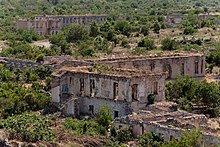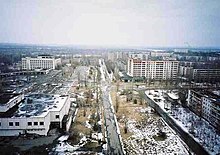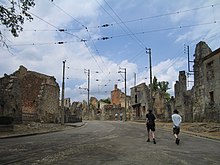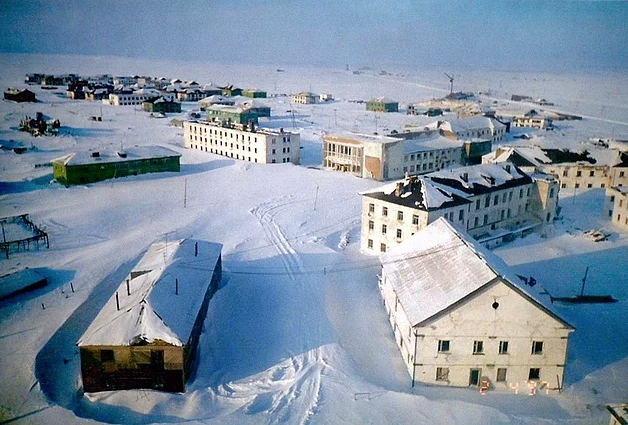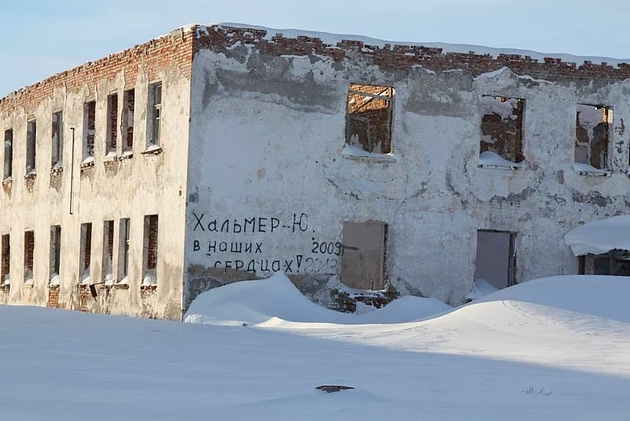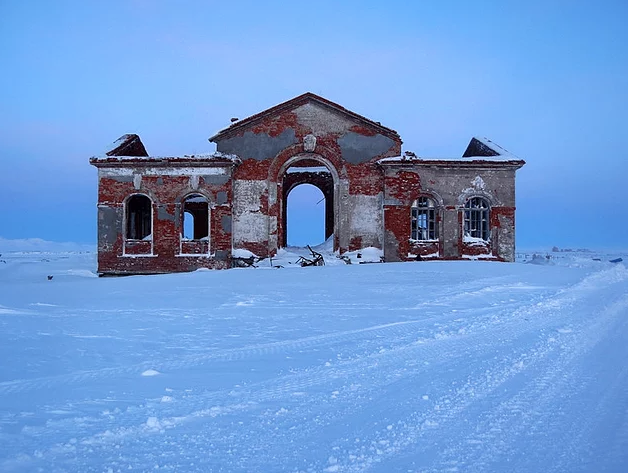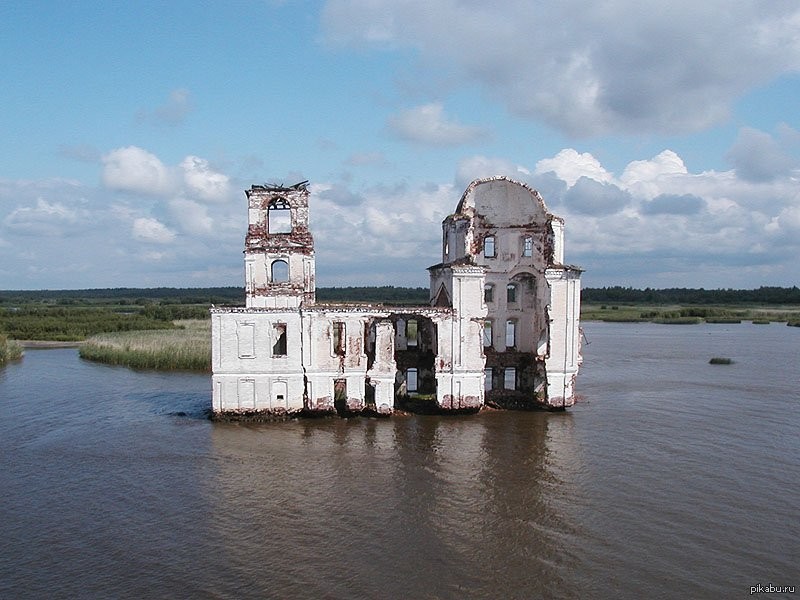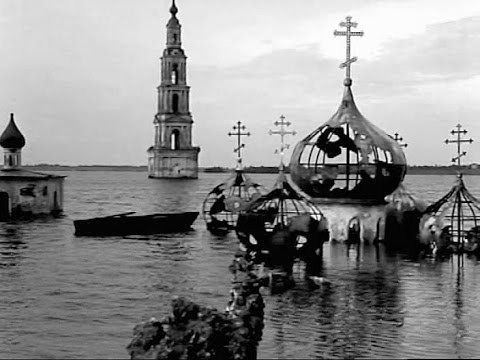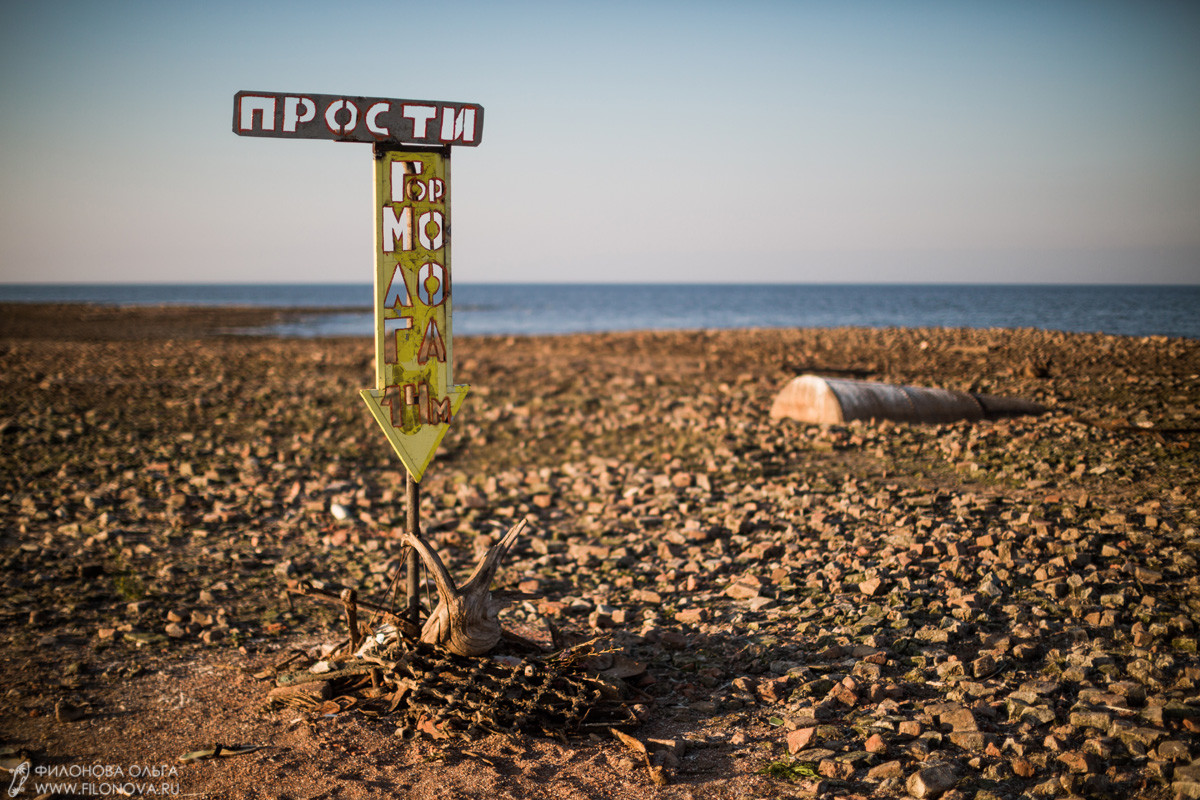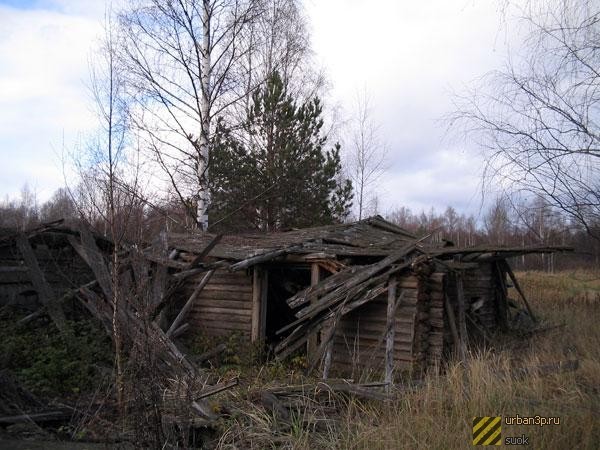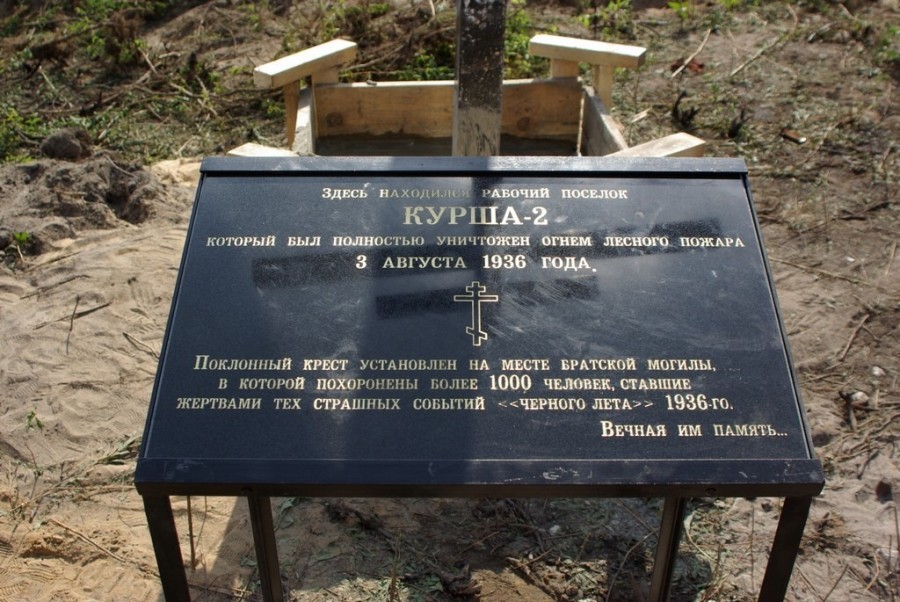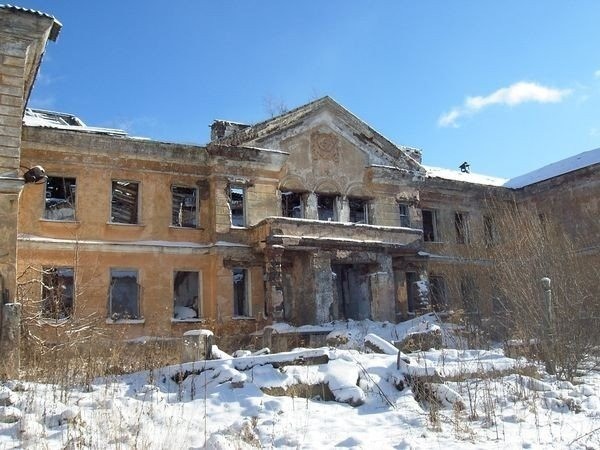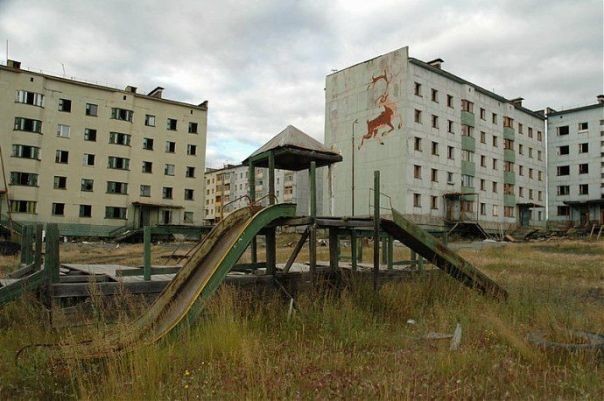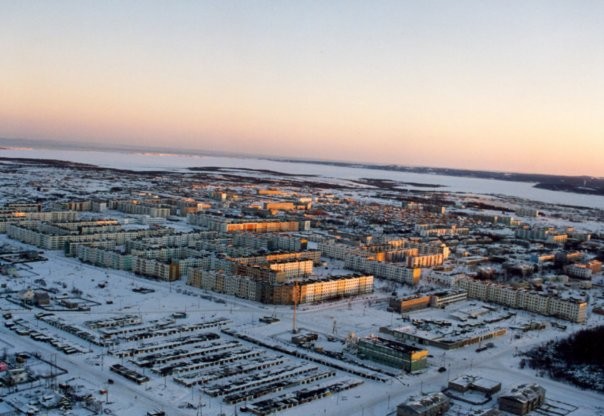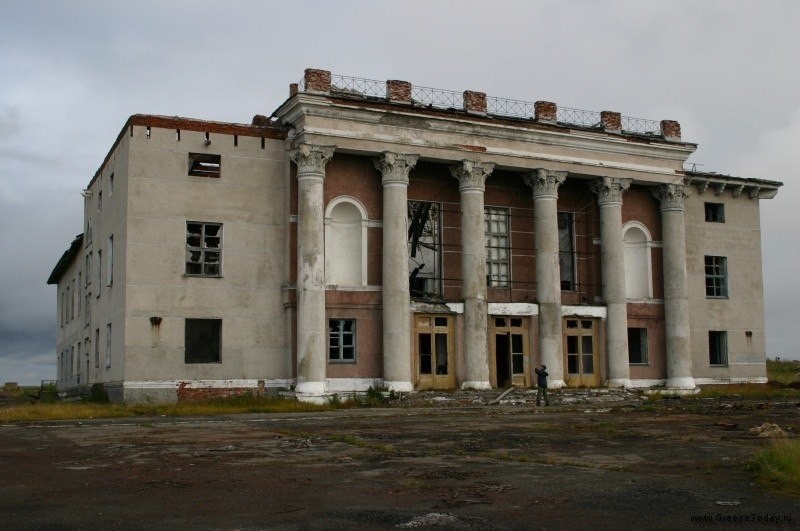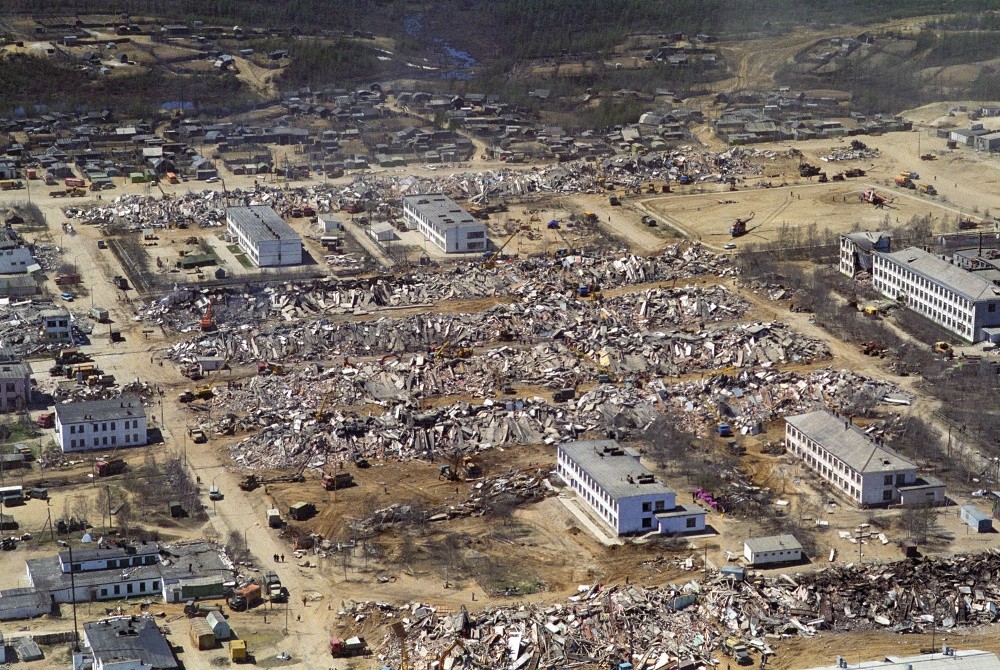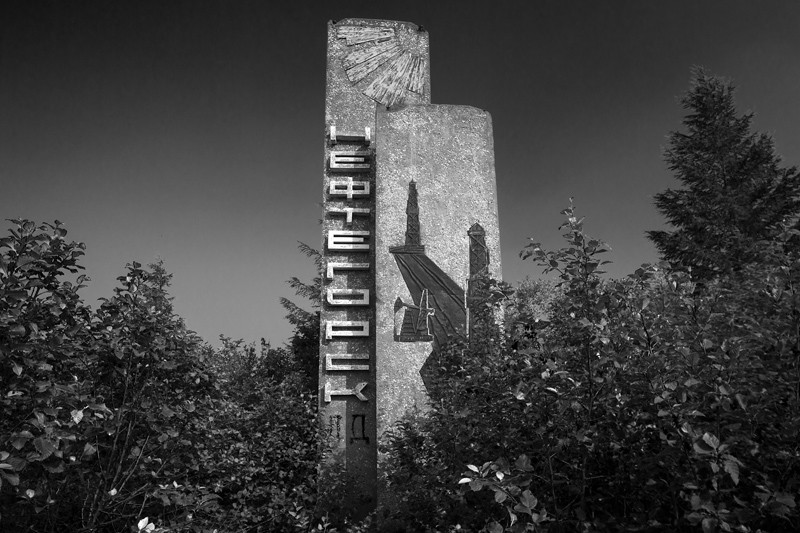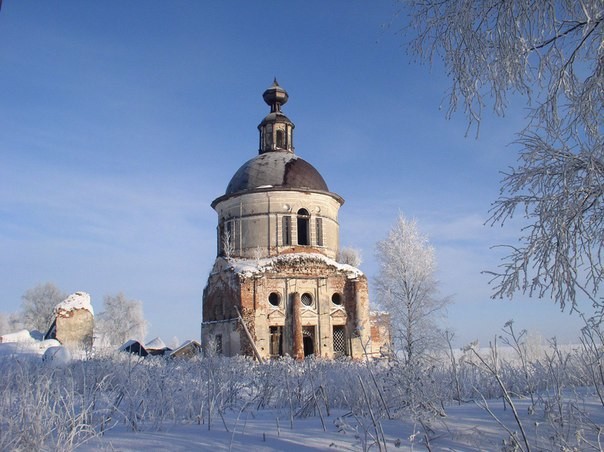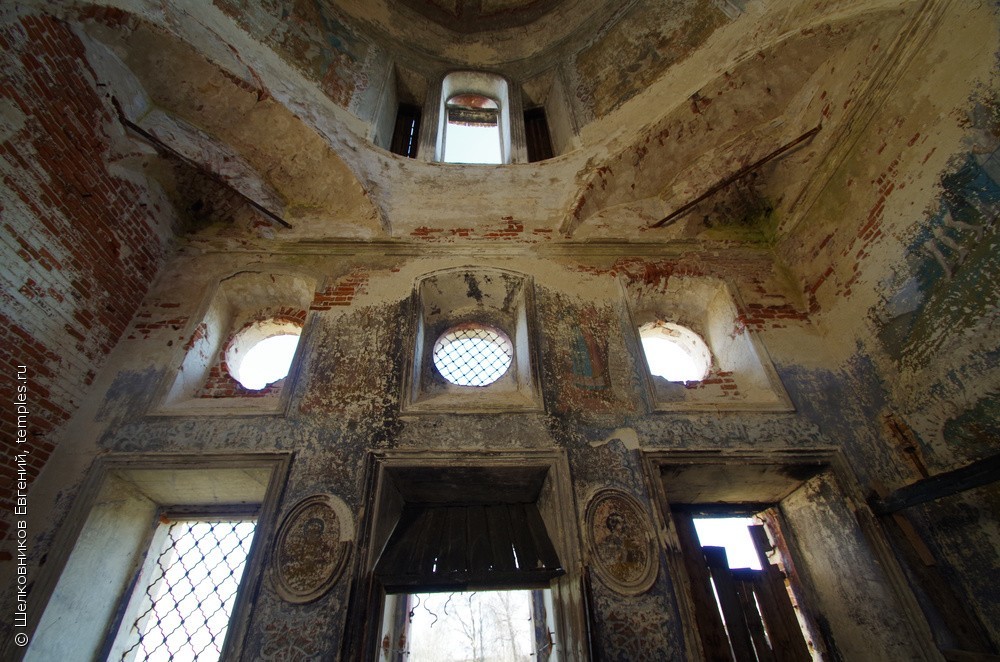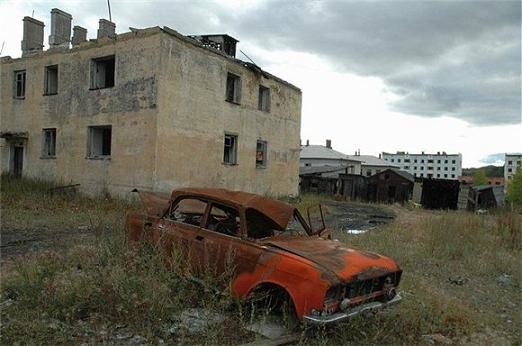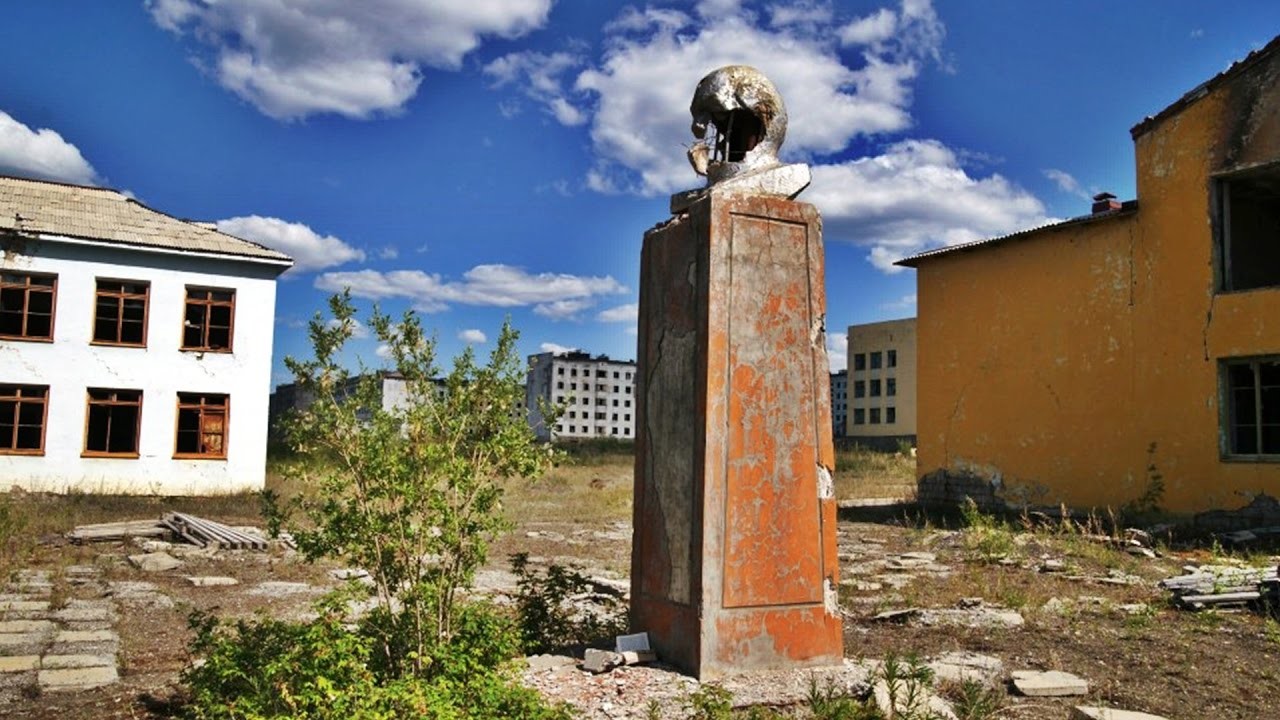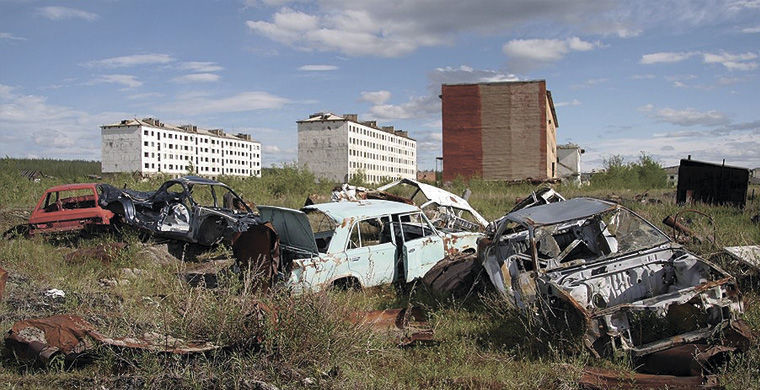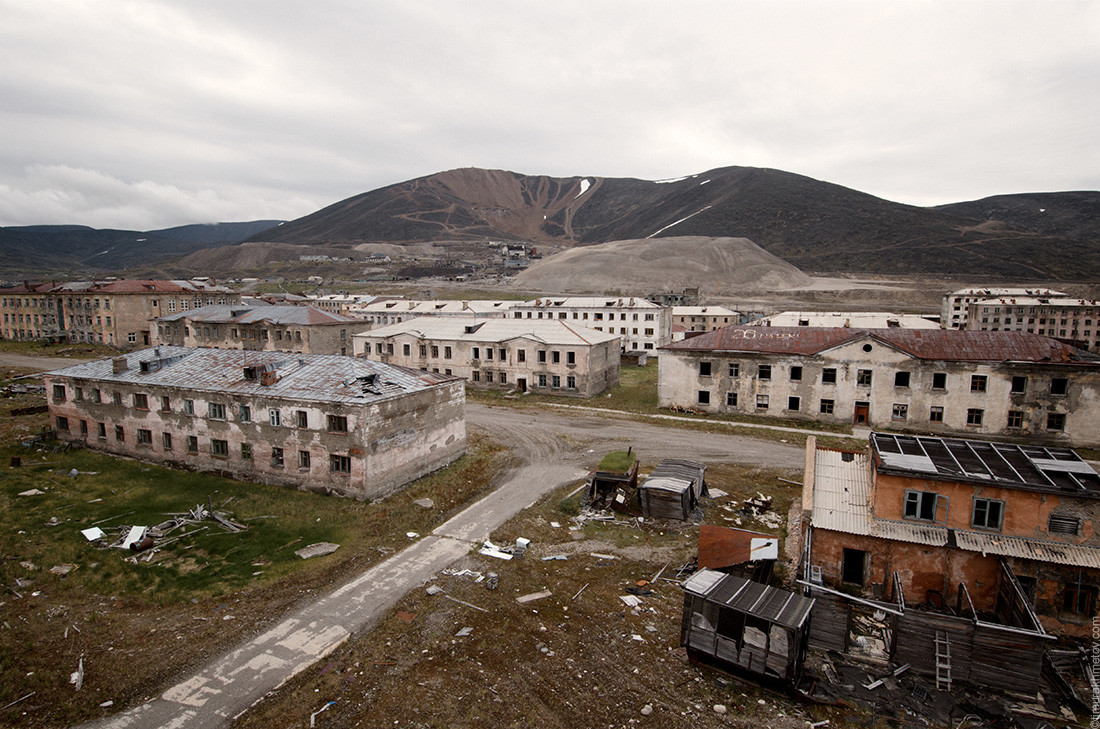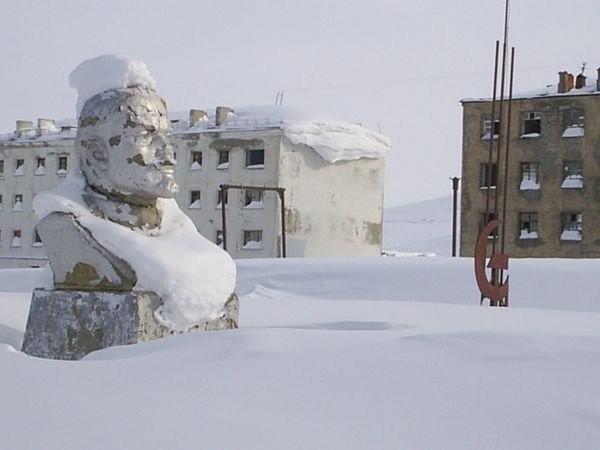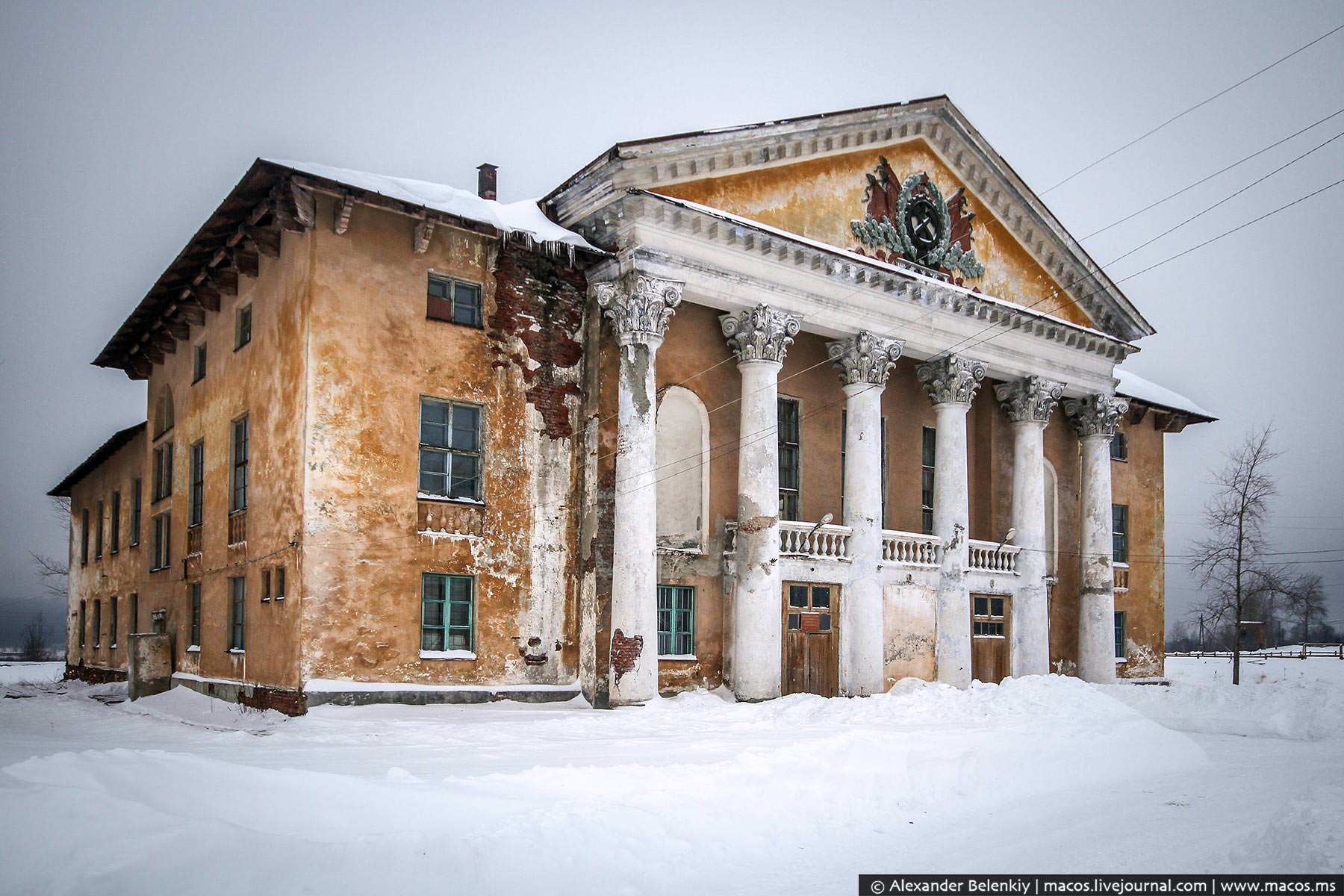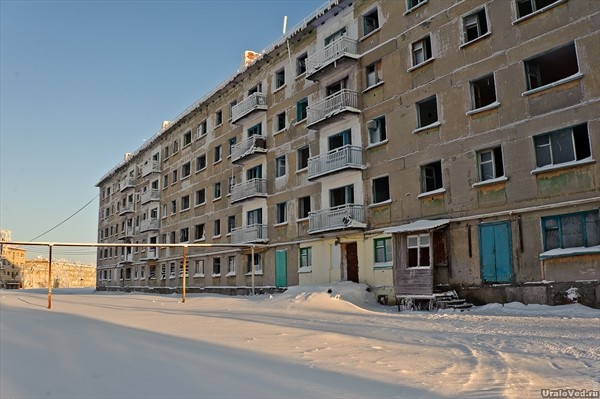Значение слова «город-призрак»

-
город-призрак
1. ru город, частично или полностью покинутый населением
Источник: Викисловарь
Делаем Карту слов лучше вместе
Привет! Меня зовут Лампобот, я компьютерная программа, которая помогает делать
Карту слов. Я отлично
умею считать, но пока плохо понимаю, как устроен ваш мир. Помоги мне разобраться!
Спасибо! Я стал чуточку лучше понимать мир эмоций.
Вопрос: притирка — это что-то нейтральное, положительное или отрицательное?
Синонимы к слову «город-призрак»
Предложения со словом «город-призрак»
- Не только потому, что лагерь действительно выглядел как настоящий город-призрак, но ещё и потому, что увидела настоящего призрака.
- Лос-Анджелес в центре по утрам напоминает опустевший город-призрак.
- И блестящий город превратился в занесённый песком город-призрак.
- (все предложения)
Понятия, связанные со словом «город-призрак»
-
Хаос Авроры (лат. Aurorae Chaos) — крупнейший из хаосов на Марсе. Он имеет длину 714 километров и достигает глубины 4.8 километра. Находится южнее экватора, вблизи Долины Маринер и каньонов Эос, Капри и Ганга. Считается, что раньше хаос был полностью под водой. Эта область изобилует деталями ландшафта, возникшими под действием мощных потоков воды. Также на рельефе Хаоса Авроры можно заметить высохшие русла рек, обрыв, демонстрирующий признаки оползней и обвалов. Был сделан снимок этой местности на…
-
«Со́сны» (англ. The Wayward Pines) — трилогия американского писателя Блейка Крауча. В трилогию входят романы «Сосны. Город в Нигде» (2012), «Сосны. Заплутавшие» (2013) и «Сосны. Последняя надежда» (2014). По трилогии снят сериал «Сосны».
-
«Голубой свет» (нем. Das blaue Licht) — художественный фильм 1931 г., первая режиссёрская работа Лени Рифеншталь. Обратил на себя внимание Гитлера.
-
Море Дьявола (другие названия треугольник дьявола, треугольник дракона, тихоокеанский треугольник, драконов треугольник) — так японские рыбаки окрестили тихоокеанские воды вокруг острова Миякедзима (в 128 км к югу от Токио), расположенные в северной части Филиппинского моря.
-
Старый Лес (англ. Old Forest; в других переводах — Древлепуща, Вековечный Лес) — в легендариуме Дж. Р. Р. Толкина о Средиземье — небольшая лесистая местность, расположенная к востоку от Шира в Бэкланде (Заскочье).
- (все понятия)
Отправить комментарий
Дополнительно
Смотрите также
-
Не только потому, что лагерь действительно выглядел как настоящий город-призрак, но ещё и потому, что увидела настоящего призрака.
-
Лос-Анджелес в центре по утрам напоминает опустевший город-призрак.
-
И блестящий город превратился в занесённый песком город-призрак.
- (все предложения)
- мёртвые города
- район трущоб
- следы разрушения
- музей под открытым небом
- узкие улочки
- (ещё синонимы…)
This article is about the term for a relatively recently abandoned settlement. For the archaeological term for an abandoned settlement, see Abandoned village.
Plymouth, Montserrat, is the only ghost town that is the capital of a modern political territory.
A ghost town (deserted city or abandoned city) is an abandoned village, town, or city, usually one that contains substantial visible remaining buildings and infrastructure such as roads. A town often becomes a ghost town because the economic activity that supported it (usually industrial or agricultural) has failed or ended for any reason (e.g. a host ore deposit exhausted by metal mining). The town may also have declined because of natural or human-caused disasters such as floods, prolonged droughts, extreme heat or extreme cold, government actions, uncontrolled lawlessness, war, pollution, or nuclear disasters. The term can sometimes refer to cities, towns, and neighbourhoods that, though still populated, are significantly less so than in past years; for example, those affected by high levels of unemployment and dereliction.[1]
Some ghost towns, especially those that preserve period-specific architecture, have become tourist attractions. Some examples are Bannack, Montana, in the United States, Barkerville, British Columbia, in Canada, Craco in Italy, Aghdam in Azerbaijan, Kolmanskop in Namibia, Pripyat in Ukraine, Dhanushkodi in India and Fordlândia in Brazil.
The town of Plymouth on the Caribbean island of Montserrat is a ghost town that is the de jure capital of Montserrat. It was rendered uninhabitable by volcanic ash from an eruption of the Soufrière Hills Volcano in 1995 and has remained so.
Definition[edit]
The definition of a ghost town varies between individuals, and between cultures. Some writers discount settlements that were abandoned as a result of a natural or human-made disaster or other causes using the term only to describe settlements that were deserted because they were no longer economically viable; T. Lindsey Baker, author of Ghost Towns of Texas, defines a ghost town as «a town for which the reason for being no longer exists».[1] Some believe that any settlement with visible tangible remains should not be called a ghost town;[2] others say, conversely, that a ghost town should contain the tangible remains of buildings.[3] Whether or not the settlement must be completely deserted, or may contain a small population, is also a matter for debate.[2] Generally, though, the term is used in a looser sense, encompassing any and all of these definitions. American author Lambert Florin’s defined a ghost town as «a shadowy semblance of a former self».[4]
Reasons for abandonment[edit]
Factors leading to the abandonment of towns include depleted natural resources, economic activity shifting elsewhere, railroads and roads bypassing or no longer accessing the town, human intervention, disasters, massacres, wars, and the shifting of politics or fall of empires.[5] A town can also be abandoned when it is part of an exclusion zone due to natural or man-made causes.
Economic activity shifting elsewhere[edit]
As farms industrialize, smaller farms are no longer economically viable, leading to rural decay.
Ghost towns may result when the single activity or resource that created a boomtown (e.g., nearby mine, mill or resort) is depleted or the resource economy undergoes a «bust» (e.g., catastrophic resource price collapse). Boomtowns can often decrease in size as fast as they initially grew. Sometimes, all or nearly the entire population can desert the town, resulting in a ghost town.
The dismantling of a boomtown can often occur on a planned basis. Mining companies nowadays will create a temporary community to service a mine site, building all the accommodations, shops and services required, and then remove them once the resource has been extracted. Modular buildings can be used to facilitate the process. A gold rush would often bring intensive but short-lived economic activity to a remote village, only to leave a ghost town once the resource was depleted.
In some cases, multiple factors may remove the economic basis for a community; some former mining towns on U.S. Route 66 suffered both mine closures when the resources were depleted and loss of highway traffic as US 66 was diverted from places like Oatman, Arizona, onto a more direct path. Mine and pulp mill closures have led to many ghost towns in British Columbia, Canada, including several relatively recent ones: Ocean Falls, which closed in 1973 after the pulp mill was decommissioned; Kitsault, whose molybdenum mine shut down after only 18 months in 1982; and Cassiar, whose asbestos mine operated from 1952 to 1992.
In other cases, the reason for abandonment can arise from a town’s intended economic function shifting to another, nearby place. This happened to Collingwood, Queensland, in Outback Australia when nearby Winton outperformed Collingwood as a regional centre for the livestock-raising industry. The railway reached Winton in 1899, linking it with the rest of Queensland, and Collingwood was a ghost town by the following year. More broadly across Australia, there has been a shift towards fly-in fly-out arrangements over building a company town, in order to avoid the development of ghost towns once a mining resource has been fully extracted.[6]
The Middle East has many ghost towns that were created when the shifting of politics or the fall of empires caused capital cities to be socially or economically unviable, such as Ctesiphon.
The rise of real-estate speculation and the resulting possibility of real-estate bubbles (sometimes due to outright overbuilding by land developers) may also trigger the appearance of certain elements of a ghost town, as real-estate prices initially rise (whereupon affordable housing becomes less available) and then later fall for a variety of reasons that are often tied to economic cycles and/or marketing hubris. This has been observed to occur in various countries, including Spain, China, the United States, and Canada, where housing is often used as an investment rather than for habitation.
Human intervention[edit]
Railroads and roads bypassing or no longer reaching a town can also create a ghost town. This was the case in many of the ghost towns along Ontario’s historic Opeongo Line, and along U.S. Route 66 after motorists bypassed the latter on the faster moving highways I-44 and I-40. Some ghost towns were founded along railways where steam trains would stop at periodic intervals to take on water. Amboy, California, was part of one such series of villages along the Atlantic and Pacific Railroad across the Mojave Desert.
River re-routing is another factor, one example being the towns along the Aral Sea.
Ghost towns may be created when land is expropriated by a government, and residents are required to relocate. One example is the village of Tyneham in Dorset, England, acquired during World War II to build an artillery range.
A similar situation occurred in the U.S. when NASA acquired land to construct the John C. Stennis Space Center (SSC), a rocket testing facility in Hancock County, Mississippi (on the Mississippi side of the Pearl River, which is the Mississippi–Louisiana state line). This required NASA to acquire a large (approximately 34-square-mile or 88-square-kilometre) buffer zone because of the loud noise and potential dangers associated with testing such rockets. Five thinly populated rural Mississippi communities (Gainesville, Logtown, Napoleon, Santa Rosa, and Westonia), plus the northern portion of a sixth (Pearlington), along with 700 families in residence, had to be completely relocated away from the facility.
Sometimes the town might cease to officially exist, but the physical infrastructure remains. For example, the five Mississippi communities that had to be abandoned to build SSC still have remnants of those communities within the facility itself. These include city streets, now overgrown with forest flora and fauna, and a one-room schoolhouse. Another example of infrastructure remaining is the former town of Weston, Illinois, that voted itself out of existence and turned the land over for construction of the Fermi National Accelerator Laboratory. Many houses and even a few barns remain, used for housing visiting scientists and storing maintenance equipment, while roads that used to cross through the site have been blocked off at the edges of the property, with gatehouses or barricades to prevent unsupervised access.
Flooding by dams[edit]
Construction of dams has produced ghost towns that have been left underwater. Examples include:
- Loyston, Tennessee, U.S., inundated by the creation of Norris Dam and reconstructed on nearby higher ground[7]
- St. Thomas, Nevada, U.S., flooded by up to 70 feet of water by Lake Mead following construction of the Hoover Dam[8]
- The Lost Villages of Ontario, flooded by Saint Lawrence Seaway construction in 1958[9]
- Nether Hambleton and Middle Hambleton in Rutland, England, which were flooded to create Rutland Water[10]
- Ashopton and Derwent, England, flooded during the construction of the Ladybower Reservoir[11][12]
- The Tignes Dam flooded the village of Tignes in France, displacing 78 families [13]
- Mologa in Russia was flooded by the creation of Rybinsk reservoir in 1940.[14]
- Many ancient villages were abandoned during construction of the Three Gorges Dam in China, leading to the displacement of many rural people[15]
- In Guanacaste Province, Costa Rica, the town of Arenal was rebuilt to make room for the man-made Lake Arenal.[citation needed]
- Old Adaminaby in New South Wales, Australia, was flooded by a dam of the Snowy River Scheme.[16]
- Construction of the Aswan High Dam on the Nile River in Egypt submerged archaeological sites and ancient settlements, such as Buhen under Lake Nasser.[17]
- Tehri was drowned after the construction of the Tehri Dam in the Indian state of Uttarakhand.[18]
- Aceredo and five other villages in the region of Galicia, Spain, drowned by the construction of Alto Lindoso Dam downstream in Portugal in 1992[19] (later exposed after extreme drought conditions in early 2022[20][21])
Massacres[edit]
Nature slowly reclaiming the ruins in Aghdam (2010)
Some towns become deserted when their populations were massacred, deported, or expelled. Examples include Kayaköy, an ancient Greek city abandoned in 1923 as result of population exchange between Greece and Turkey and the original French village at Oradour-sur-Glane which was destroyed on 10 June 1944 when 642 of its 663 inhabitants were killed by a German Waffen-SS company. A new village was built after the war on a nearby site, and the ruins of the original have been maintained as a memorial.
Another example is Aghdam, a city in Azerbaijan. Armenian forces occupied Aghdam in July 1993 during the First Nagorno-Karabakh War. The heavy fighting forced the entire population to flee. Upon seizing the city, Armenian forces destroyed much of the town to discourage Azerbaijanis from returning. More damage occurred in the following decades when locals looted the abandoned town for building materials. It is currently almost entirely ruined and uninhabited.
Disasters, actual and anticipated[edit]
Craco, Italy, was abandoned due to a landslide in 1963. It has since become a popular film set.
Natural and man-made disasters can create ghost towns. For example, after being flooded more than 30 times since their town was founded in 1845, residents of Pattonsburg, Missouri, decided to relocate after two floods in 1993. With government help, the whole town was rebuilt 3 miles or 5 km away.
Craco, a medieval village in the Italian region of Basilicata, was evacuated after a landslide in 1963. Nowadays it is a filming location for many movies, including The Passion of The Christ by Mel Gibson, Christ Stopped at Eboli by Francesco Rosi, The Nativity Story by Catherine Hardwicke and Quantum of Solace by Marc Forster.[22]
In 1984, Centralia, Pennsylvania, was abandoned due to an uncontainable mine fire, which began in 1962 and still rages to this day; eventually the fire reached an abandoned mine underneath the nearby town of Byrnesville, Pennsylvania, which caused that mine to catch on fire too and forced the evacuation of that town as well.
Ghost towns may also occasionally come into being due to an anticipated natural disaster – for example, the Canadian town of Lemieux, Ontario, was abandoned in 1991 after soil testing revealed that the community was built on an unstable bed of Leda clay. Two years after the last building in Lemieux was demolished, a landslide swept part of the former town-site into the South Nation River. Two decades earlier, the Canadian town of Saint-Jean-Vianney, Québec, also constructed on a Leda clay base, had been abandoned after a landslide on 4 May 1971, which swept away 41 homes, killing 31 people.
Following the Chernobyl disaster of 1986, dangerously high levels of nuclear contamination escaped into the surrounding area, and nearly 200 towns and villages in Ukraine and neighbouring Belarus were evacuated, including the cities of Pripyat and Chernobyl. The area was so contaminated that many of the evacuees were never permitted to return to their homes. Pripyat is the most famous of these abandoned towns; it was built for the workers of the Chernobyl Nuclear Power Plant and had a population of almost 50,000 at the time of the disaster.[23]
Disease and contamination[edit]
Rerik West, Germany. Turned into a restricted area after 1992 due to ammunition contamination from a nearby abandoned Soviet Army barracks.
Significant fatality rates from epidemics have produced ghost towns. Some places in eastern Arkansas were abandoned after more than 7,000 Arkansans died during the Spanish flu epidemic of 1918 and 1919.[24][25] Several communities in Ireland, particularly in the west of the country, were wiped out due to the Great Famine in the latter half of the 19th century, and the years of economic decline that followed.
Catastrophic environmental damage caused by long-term contamination can also create a ghost town. Some notable examples are Times Beach, Missouri, whose residents were exposed to a high level of dioxins, and Wittenoom, Western Australia, which was once Australia’s largest source of blue asbestos, but was shut down in 1966 due to health concerns. Treece and Picher, twin communities straddling the Kansas–Oklahoma border, were once one of the United States’ largest sources of zinc and lead, but over a century of unregulated disposal of mine tailings led to groundwater contamination and lead poisoning in the town’s children, eventually resulting in a mandatory Environmental Protection Agency buyout and evacuation. Contamination due to ammunition caused by military use may also lead to the development of ghost towns. Tyneham, in Dorset, was requisitioned for military exercises during the Second World War, and remains unpopulated, being littered with unexploded munitions from regular shelling.
Ghost town repopulation[edit]
Walhalla township in 1910
Part of Walhalla in 2004, showing a mix of original and reconstructed buildings
Walhalla, Victoria, was almost abandoned after being mined for gold, but is now becoming repopulated.
A few ghost towns have managed to get a second life, and this happens through a variety of reasons.
One of these reasons is heritage tourism generating a new economy able to support residents.
For example, Walhalla, Victoria, Australia, became almost deserted[26] after its gold mine ceased operation in 1914, but owing to its accessibility and proximity to other attractive locations, it has had a recent economic and holiday population surge. Another town, Sungai Lembing, Malaysia, was almost deserted due to closure of a tin mine in 1986 was revived in 2001 and has become a tourist destination since then.[27]
Foncebadón, a village in León, Spain, that was mostly abandoned and only inhabited by a mother and son, is slowly being revived owing to the ever-increasing stream of pilgrims on the road to Santiago de Compostela.
Some ghost towns (e.g. Riace, Muñotello) are being repopulated by respectively refugees and homeless people. In Riace, this was accomplished by a scheme funded by the Italian government which offers the housing to refugees and in Muñotello it was accomplished through an NGO (Madrina Foundation).[28][29]
In Algeria, many cities became hamlets after the end of Late Antiquity. They were revived with shifts in population during and after French colonization of Algeria. Oran, currently the nation’s second-largest city with 1 million people, was a village of only a few thousand people before colonization.
Alexandria, the third-largest city of Egypt, was a flourishing city in the Ancient era, but declined during the Middle Ages. It underwent a dramatic revival during the 19th century; from a population of 5,000 in 1806, it grew into a city of more than 200,000 inhabitants by 1882,[30] and is now home to more than four million people.[31]
Around the world[edit]
Africa[edit]
Wars and rebellions in some African countries have left many towns and villages deserted. Since 2003, when President François Bozizé came to power, thousands of citizens of the Central African Republic have been forced to flee their homes as a result of the escalating conflict between armed rebels and government troops. Villages accused of supporting the rebels, such as Beogombo Deux near Paoua, are ransacked by government soldiers. Those who are not killed have no choice but to escape to refugee camps.[32] The instability in the region also leaves organized and well-equipped bandits free to terrorize the populace, often leaving villages abandoned in their wake.[33] Elsewhere in Africa, the town of Lukangol was burnt to the ground during tribal clashes in South Sudan. Before its destruction, the town had a population of 20,000.[34] The Libyan town of Tawergha had a population of around 25,000 before it was abandoned during the 2011 civil war, and it has remained empty since.
Many of the ghost towns in mineral-rich Africa are former mining towns. Shortly after the start of the 1908 diamond rush in German South-West Africa, now known as Namibia, the German Imperial government claimed sole mining rights by creating the Sperrgebiet (forbidden zone),[35] effectively criminalizing new settlement. The small mining towns of this area, among them Pomona, Elizabeth Bay and Kolmanskop, were exempt from this ban, but the denial of new land claims soon rendered all of them ghost towns.
Asia[edit]
China has many large urban property developments, sometimes referred to as «ghost cities», that have remained mostly unoccupied since they were built.[36] The town of Dhanushkodi, India is a ghost town. It was destroyed during the 1964 Rameswaram cyclone and remains uninhabited in the aftermath.[37]
Many abandoned towns and settlements in the former Soviet Union were established near Gulag labour camps to supply necessary services. Since most of these camps were abandoned in the 1950s, the towns were abandoned as well. One such town is located near the former Gulag camp called Butugychag (also called Lower Butugychag). Other towns were deserted due to deindustrialisation and the economic crises of the early 1990s attributed to post-Soviet conflicts – one example being Tkvarcheli in Georgia, a coal mining town that suffered a drastic population decline as a result of the War in Abkhazia in the early 1990s.
Antarctica[edit]
The derelict British base in Whalers Bay, Deception Island, destroyed by a volcanic eruption
The oldest ghost town in Antarctica is on Deception Island, where in 1906, a Norwegian-Chilean company set up a whaling station at Whalers Bay, which they used as a base for their factory ship, the Gobernador Bories. Other whaling operations followed suit, and by 1914 there were thirteen factory ships based there. The station ceased to be profitable during the Great Depression, and was abandoned in 1931. In 1969, the station was partially destroyed by a volcanic eruption. There are also many abandoned scientific and military bases in Antarctica, especially in the Antarctic Peninsula.
The Antarctic island of South Georgia used to have several thriving whaling settlements during the first half of the 20th century, with a combined population exceeding 2,000 in some years. These included Grytviken (operating 1904–64), Leith Harbour (1909–65), Ocean Harbour (1909–20), Husvik (1910–60), Stromness (1912–61) and Prince Olav Harbour (1917–34). The abandoned settlements have become increasingly dilapidated, and remain uninhabited nowadays except for the Museum curator’s family at Grytviken. The jetty, the church, dwellings and industrial buildings at Grytviken have recently been renovated by the South Georgian Government, becoming a popular tourist destination. Some historical buildings in the other settlements are being restored as well.
Europe[edit]
Urbanization – the migration of a country’s rural population into the cities – has left many European towns and villages deserted. An increasing number of settlements in Bulgaria are becoming ghost towns for this reason; at the time of the 2011 census, the country had 181 uninhabited settlements.[38] In Hungary, dozens of villages are also threatened with abandonment. The first village officially declared as «dead» was Gyűrűfű in the late 1970s, but later it was repopulated as an eco-village. Some other depopulated villages were successfully saved as small rural resorts, such as Kán, Tornakápolna, Szanticska, Gorica, and Révfalu.
In Spain, large zones of the mountainous Iberian System and the Pyrenees have undergone heavy depopulation since the early 20th century, leaving a string of ghost towns in areas such as the Solana Valley. Traditional agricultural practices such as sheep and goat rearing, on which the mountain village economy was based, were not taken over by the local youth, especially after the lifestyle changes that swept over rural Spain during the second half of the 20th century.[39]
Examples for ghost towns in Italy include the medieval village of Fabbriche di Careggine near Lago di Vagli, Tuscany,[40] the deserted mountain village Craco located in Basilicata, which has served as a filming location,[41] and the ghost village Roveraia, in the municipality of Loro Ciuffenna, in province of Arezzo, situated near Pratovalle. During World War II it was an important partisan base[42][43][44] and it was definitively abandoned in the 1980s, when the last family who lived here, left the village.[citation needed]. Two projects have been proposed for the recovery of the village: in 2011 the proposal of Movimento Libero Perseo «Roveraia eco — lab», based on sustainability,[45][46][47] and in 2019 there was a proposal aiming to recover the village with a mix of functions called «Ecomuseum of Pratomagno».[48][49][50][51]
In the United Kingdom, thousands of villages were abandoned during the Middle Ages, as a result of Black Death, revolts, and enclosure, the process by which vast amounts of farmland became privately owned. Since there are rarely any visible remains of these settlements, they are not generally considered ghost towns; instead, they are referred to in archaeological circles as deserted medieval villages.
Sometimes, wars and genocide end a town’s life. In 1944, occupying German Waffen-SS troops murdered almost the entire population of the French village Oradour-sur-Glane. A new settlement was built nearby after the war, but the old town was left depopulated on the orders of President Charles de Gaulle, as a permanent memorial. In Germany, numerous smaller towns and villages in the former eastern territories were completely destroyed in the last two years of the war. These territories later became part of Poland and the Soviet Union, and many of the smaller settlements were never rebuilt or repopulated, for example Kłomino (Westfalenhof), Pstrąże (Pstransse), and Janowa Góra (Johannesberg). Some villages in England were also abandoned during the war, but for different reasons. Imber, on Salisbury Plain, and several villages in the Stanford Battle Area, were commandeered by the War Office for use as training grounds for British and US troops. Although this was intended to be a temporary measure, the residents were never allowed to return, and the villages have been used for military training ever since. Three miles or 5 km southeast of Imber is Copehill Down, a deserted village purpose-built for training in urban warfare.
Disasters have played a part in the abandonment of settlements within Europe. After the Chernobyl disaster of 1986, the cities of Pripyat and Chernobyl were evacuated due to dangerous radiation levels within the area. As of today, Pripyat remains completely abandoned, and Chernobyl has around 500 remaining inhabitants.
An example in the UK of a ghost village which was abandoned before it was ever occupied is at Polphail, Argyll and Bute. The planned development of an oil rig construction facility nearby never materialised, and a village built to house the workers and their families became deserted the moment the building contractors finished their work.
North America[edit]
Canada[edit]
Canada has several ghost towns in parts of British Columbia, Alberta, Ontario, Saskatchewan, Newfoundland and Labrador, and Quebec. Some were logging towns or dual mining and logging sites, often developed at the behest of the company. In Alberta and Saskatchewan, most ghost towns were once farming communities that have since died off due to the removal of the railway through the town or the bypass of a highway. The ghost towns in British Columbia were predominantly mining towns and prospecting camps as well as canneries and, in one or two cases, large smelter and pulp mill towns. British Columbia has more ghost towns than any other jurisdiction on the North American continent, with more than 1,500 abandoned or semi-abandoned towns and localities.[52] Among the most notable are Anyox, Kitsault, and Ocean Falls.
Some ghost towns have revived their economies and populations due to historical and eco-tourism, such as Barkerville; once the largest town north of Kamloops, it is now a year-round provincial museum. In Quebec, Val-Jalbert is a well-known tourist ghost town; founded in 1901 around a mechanical pulp mill that became obsolete when paper mills began to break down wood fibre by chemical means, it was abandoned when the mill closed in 1927 and re-opened as a park in 1960.
United States[edit]
Many ghost towns or abandoned communities exist in the American Great Plains, the rural areas of which have lost a third of their population since 1920. Thousands of communities in the northern plains states of Montana, Nebraska, North Dakota, and South Dakota became railroad ghost towns when a rail line failed to materialize. Hundreds of towns were abandoned as the Interstate highway system replaced the railroads as the favored means of transportation. Ghost towns are common in mining or mill towns in all the western states, and many eastern and southern states as well. Residents are compelled to leave in search of more productive areas when the resources that had created an employment boom in these towns were eventually exhausted.
Sometimes a ghost town consists of many abandoned buildings as in Bodie, California, or standing ruins as in Rhyolite, Nevada, while elsewhere only the foundations of former buildings remain as in Graysonia, Arkansas. Old mining camps that have lost most of their population at some stage of their history such as Aspen, Deadwood, Oatman, Tombstone and Virginia City are sometimes referred to as ghost towns although they are presently active towns and cities.[citation needed] Many U.S. ghost towns, such as South Pass City in Wyoming[53] are listed on the National Register of Historic Places.[54]
Starting in 2002, an attempt to declare an official ghost town in California stalled when the adherents of the town of Bodie and those of Calico, in Southern California, could not agree on the most deserving settlement for the recognition. A compromise was eventually reached—Bodie became the official state gold rush ghost town, while Calico was named the official state silver rush ghost town.[55]
Another former mining town, Real de Catorce in Mexico, has been used as a backdrop for Hollywood movies such as The Treasure of the Sierra Madre (1948),[56] The Mexican (2001), and Bandidas (2006).[57]
South America[edit]
In the late 19th and early 20th centuries, a wave of European immigrants arrived in Brazil and settled in the cities, which offered jobs, education, and other opportunities that enabled newcomers to enter the middle class. Many also settled in the growing small towns along the expanding railway system. Since the 1930s, many rural workers have moved to the big cities. Other ghost towns were created in the aftermath of dinosaur fossil rushes.[58]
In Colombia, a volcano erupted in 1985, where the city of Armero was engulfed by lahars, which killed approximately 23,000 people in total.[59] Armero was never rebuilt (its inhabitants being diverted to nearby cities, and thus becoming a ghost town), but still stands today as «holy land», as dictated by Pope John Paul II.[60]
A number of ghost towns throughout South America were once mining camps or lumber mills, such as the many saltpeter mining camps that prospered in Chile from the end of the Saltpeter War until the invention of synthetic saltpeter during World War I. Some of these towns, such as the Humberstone and Santa Laura Saltpeter Works in the Atacama Desert, have been declared UNESCO World Heritage Sites.[61]
Oceania[edit]
The boom and bust of gold rushes and the mining of other ores has led to a number of ghost towns in both Australia and New Zealand. Other towns have become abandoned whether due to natural disasters, the weather, or the drowning of valleys to increase the size of lakes.
In Australia, the Victoria gold rush led to numerous ghost towns (such as Cassilis and Moliagul), as did the hunt for gold in Western Australia (for example, the towns of Ora Banda and Kanowna). The mining of iron and other ores has also led to towns thriving briefly before dwindling.
In New Zealand, the Otago gold rush similarly led to several ghost towns (such as Macetown). New Zealand’s ghost towns also include numerous coal mining areas in the South Island’s West Coast Region, including Denniston and Stockton. Natural disasters have also led to the loss of some towns, notably Te Wairoa, «The Buried Village», destroyed in the 1886 eruption of Mount Tarawera, and the Otago town of Kelso, abandoned after it was flooded repeatedly after heavy rainstorms. Early settlements on the rugged southwest coast of the South Island at Martins Bay and Port Craig were also abandoned, mainly due to the inhospitable terrain.
See also[edit]
- Abandoned mine
- Abandoned village
- Exclusion zone
- Ghost ship
- List of ghost towns by country
- Lost cities
- Modern ruins
- Old field (ecology)
- Phantom settlement
- Potemkin village
- Unused highway
- Urban decay
- Urban exploration
- Yellowcake boomtown
References[edit]
- ^ a b Baker, T. Lindsay (2003). More Ghost Towns of Texas. Norman, OK: University of Oklahoma Press. ISBN 0-8061-3518-2.
- ^ a b Brown, Robert L. (1990). Ghost Towns of the Colorado Rockies. Caldwell, Idaho: Caxton Printers. p. 15. ISBN 0-87004-342-0.
- ^ Thomsen, Clint (2012). «What is a ghost town?». Ghost Towns: Lost Cities of the Old West. Osprey Publishing. ISBN 978-1-78200-107-2.
- ^ Hall, Shawn (2010). Ghost Towns and Mining Camps of Southern Nevada. Charleston, SC: Arcadia Pub. p. 7. ISBN 978-0738570129.
- ^ Graves, Philip; Weiler, Stephan; Tynon, Emily (25 January 2010). «The Economics of Ghost Towns». Social Science Research Network. SSRN 1540770.
- ^ Peace, Adrian (2015). «Australia, Sociocultural Overviews: Australian Settler Society». International Encyclopedia of the Social & Behavioral Sciences (Second Edition): 239–244. doi:10.1016/B978-0-08-097086-8.12022-7. ISBN 9780080970875. Retrieved 21 October 2022.
- ^ Watts, Jennifer. «Underwater Ghost Towns of Tennessee». Tennessee State Museum. Retrieved 26 February 2023.
- ^ «St Thomas Nevada — Lake Mead National Recreation Area (U.S. National Park Service)». National Park Service. National Park Service. Retrieved 26 February 2023.
- ^ Wheeler, Maggie. «The Lost Villages». The Canadian Encyclopedia. Historica Canada. Retrieved 26 February 2023.
- ^ «Hambleton, Upper Hambleton, Middle Hambleton, Nether Hambleton». Survey of English Place-Names. English Place-Name Society. Retrieved 26 February 2023.
- ^ York, Chris. «Two Lost Derbyshire Villages Have Been revealed By Low WaterLevels At Ladybower Reservoir». HuffPost UK News. Huffington Post. Retrieved 26 February 2023.
- ^ «Ladybower». Peak District National Park. Retrieved 26 February 2023.
- ^ «Village Destroyed as New Dam Floods Reservoir». British Pathe. Reuters. Retrieved 26 February 2023.
- ^ Mandraud, Isabelle (30 January 2015). «Sunken towns of the Volga revive memories of Stalinist-era Russia». The Guardian.
- ^ «Three Gorges Dam». Encyclopedia Britannica. Britannica. Retrieved 26 February 2023.
- ^ Elder, Bruce. «A Complete Guide to Adaminaby, NSW». Australian Geographic. Retrieved 26 February 2023.
- ^ Harford, Tim. «The Spectacular Failures and Successes of Massive Dams». BBC News. BBC. Retrieved 26 February 2023.
- ^ «New Tehri — Overlooks The Gigantic Tehri Lake And Dam | Uttarakhand Tourism». Uttarakhand Tourism.
- ^ Pontevedra, Silvia R. (14 December 2012). «Memoria de un pueblo ahogado». El País (in Spanish). Retrieved 21 February 2022.
- ^ «Ghost village emerges in Spain as drought empties reservoir». The Guardian. 12 February 2022. Retrieved 21 February 2022.
- ^ Butterfield, Michelle (18 February 2022). «Incredible photos show Spanish ghost village emerge after 30 years underwater». Global News. Retrieved 21 February 2022.
- ^ «Most Popular Titles With Location Matching «Craco, Matera, Basilicata, Italy»«. Internet Movie Database. Retrieved 15 November 2013.
- ^ Mould, R. F. (2000). «Evacuation and Resettlement». Chernobyl Record: The Definitive History of the Chernobyl Catastrophe. Bristol: Institute of Physics Publishing. pp. 103–117. ISBN 0-7503-0670-X.
- ^ Brundage, John F.; Shanks, G. Dennis (August 2008). «Deaths from Bacterial Pneumonia during 1918–19 Influenza Pandemic». Emerging Infectious Diseases. U.S. Centers for Disease Control. 14 (8): 1193–1199. doi:10.3201/eid1408.071313. PMC 2600384. PMID 18680641. Retrieved 11 July 2010.
- ^ Annual report of the Surgeon General of the Public Health Service of the United States — 1920. Washington, DC: Public Health Service.
- ^ «Frequently-Asked Questions about Walhalla». walhalla.org.au. Walhalla Heritage and Development League Inc. 2006–2013. Retrieved 12 January 2014.
- ^ Pek Yee, Foong (14 July 2017). «Ex-mining town embraces ecotourism». The Star. Retrieved 5 July 2020.
- ^ «Riace: The Italian village abandoned by locals, adopted by migrants». BBC News. 25 September 2016.
- ^ Spain’s homeless help repopulate rural ghost towns
- ^ Ágoston, Gábor; Masters, Bruce (2009). Encyclopedia of the Ottoman Empire. Infobase Publishing. p. 33. ISBN 978-1-4381-1025-7.
- ^ The World Factbook – Egypt. Central Intelligence Agency. Retrieved 13 September 2012.
- ^ Thompson, Mike (15 December 2008). «Deserted villages and abandoned lives». BBC News. Retrieved 18 December 2008.
- ^ Thompson, Mike (18 December 2008). «Massacre haunts CAR villagers». BBC News. Retrieved 18 December 2008.
- ^ «South Sudan ‘sends more troops’ to strife-torn town Pibor». BBC News. 1 January 2012. Retrieved 1 January 2012.
- ^ Santcross, Nick; Ballard, Sebastian; Baker, Gordon (2001). Namibia Handbook: The Travel Guide. Footprint Handbooks. ISBN 1-900949-91-1.
- ^ Shephard, Wade (2015). Ghost Cities of China: The Story of Cities without People in the World’s Most Populated Country. Zed Books. ISBN 978-1-78360-218-6.
- ^ Duttagupta, Samonway. «Did you know? Dhanushkodi is the place where you can see the origin of the Ram Setu!». India Today. Retrieved 2 May 2020.
- ^ «Bulgaria’s population is 7.3 million – official 2011 census results». The Sofia Echo. 21 July 2011. Archived from the original on 8 February 2013. Retrieved 21 August 2012.
- ^ «Sos Mundo Rural Aragonés alerta de la despoblación de los pueblos» (in Spanish). Diario de Teruel. 12 March 2013. Archived from the original on 15 March 2013. Retrieved 11 April 2013.
- ^ «Lake of Vagli». Italy Undiscovered. 14 June 2015. Archived from the original on 29 November 2020. Retrieved 17 February 2021.
- ^ «Craco, the Ghost Town jewel of Basilicata». visititaly.eu. Retrieved 17 February 2021.
- ^ «Rappresaglie di San Giustino». resistenzatoscana.org (in Italian). Retrieved 20 October 2021.
{{cite web}}: CS1 maint: url-status (link) - ^ «Sui pendii occidentali del Pratomagno». arezzomassacri.weebly.com (in Italian). Retrieved 20 October 2021.
{{cite web}}: CS1 maint: url-status (link)[unreliable source?] - ^ Brezi, Alessandro (2018). Poppi 1944 Storia e storie di un paese nella Linea Gotica (PDF) (in Italian). Regione Toscana. ISBN 978-88-85617-09-4. Archived (PDF) from the original on 29 January 2021.
- ^ «Il Progetto delle Funzioni». Scribd. Movimento Libero Perseo. Retrieved 17 October 2021.
- ^ «Roveraia eco — lab». Vimeo. Movimento Libero Perseo. Retrieved 17 October 2021.
- ^ «Roveraia. Un progetto ecosostenibile di tutta eccellenza». L’Evidenziatore del Web. Retrieved 17 October 2021.
- ^ «Ecomuseo del Pratomagno by Emma Amidei». Issuu. DIDA — Department of architecture, University of Florence. Retrieved 17 October 2021.
- ^ «Porfolio di architettura by Emma Amidei». Issuu. Emma Amidei. Retrieved 17 October 2021.
- ^ «Architecture porfolio by Emma Amidei». Issuu. Emma Amidei.
- ^ «Ecomuseum of Pratomagno». KooZA/rch. KooZA/rch. Retrieved 17 October 2021.
- ^ Ramsey, Bruce (1963–1975). Ghost Towns of British Columbia». Vancouver: Mitchell Press.
- ^ Weis, Norman D. (1971). Ghost Towns of the Northwest. Caldwell, Idaho, USA: Caxton Press. ISBN 0-87004-358-7.
- ^ «National Register Information System». National Register of Historic Places. National Park Service. 13 March 2009.
- ^ «California State Gold Rush Ghost Town». NetState. Retrieved 28 December 2011.
- ^ Barlow, Maude (2013). «BARLOW IN MEXICO (DAYS SIX TO EIGHT)». The Council of Canadians.
{{cite web}}: CS1 maint: url-status (link) - ^ «Bandidas (2006) Filming & Production». IMDb.
{{cite web}}: CS1 maint: url-status (link) - ^ Baraniuk, Chris (15 July 2016). «The ghost towns that were created by the oil rush». BBC.
- ^ «Benchmarks: November 13, 1985: Nevado del Ruiz eruption triggers deadly lahars». Earth Magazine. American Geosciences Institute. Retrieved 13 November 2016.
- ^ Zeiderman, Austin (2009). Life at Risk: Biopolitics, Citizenship, and Security in Colombia. Congress of the Latin American Studies Association. p. 12. CiteSeerX 10.1.1.509.6961.
- ^ «Humberstone and Santa Laura Saltpeter Works». whc.unesco.org. UNESCO World Heritage Centre.
{{cite web}}: CS1 maint: url-status (link)
Bibliography[edit]
- Baker, T. Lindsay (1991). Ghost Towns of Texas (2nd ed.). Norman: University of Oklahoma Press. ISBN 0-8061-2189-0.
- McIntyre, Tobi; Politis, Paul (September–October 2005). «Standing legacy: Ghost towns preserve the Ottawa Valley’s rich history». Canadian Geographic. Archived from the original on 16 June 2016. Retrieved 3 October 2005.
- Steinhilber, Berthold (2003). Ghost Towns of the American West. New York: Harry N. Abrams. ISBN 0-8109-4508-8.
- Wolle, Muriel Sibell (1993) [1977]. Timberline Tailings: Tales of Colorado’s Ghost Towns and Mining Camps (1st ed.). Athens, Ohio: Swallow Press/Ohio University Press. ISBN 0-8040-0963-5.
- Wolle, Muriel Sibell (1991). Stampede to Timberline: The Ghost Towns and Mining Camps of Colorado (2nd ed.). Athens, OH: Swallow Press/Ohio University Press. ISBN 0-8040-0946-5.
Further reading[edit]
- Curtis, Daniel R. «Pre-industrial societies and strategies for the exploitation of resources. A theoretical framework for understanding why some settlements are resilient and some settlements are vulnerable to exploitation». Academica.edu.
Look up ghost town in Wiktionary, the free dictionary.
This article is about the term for a relatively recently abandoned settlement. For the archaeological term for an abandoned settlement, see Abandoned village.
Plymouth, Montserrat, is the only ghost town that is the capital of a modern political territory.
A ghost town (deserted city or abandoned city) is an abandoned village, town, or city, usually one that contains substantial visible remaining buildings and infrastructure such as roads. A town often becomes a ghost town because the economic activity that supported it (usually industrial or agricultural) has failed or ended for any reason (e.g. a host ore deposit exhausted by metal mining). The town may also have declined because of natural or human-caused disasters such as floods, prolonged droughts, extreme heat or extreme cold, government actions, uncontrolled lawlessness, war, pollution, or nuclear disasters. The term can sometimes refer to cities, towns, and neighbourhoods that, though still populated, are significantly less so than in past years; for example, those affected by high levels of unemployment and dereliction.[1]
Some ghost towns, especially those that preserve period-specific architecture, have become tourist attractions. Some examples are Bannack, Montana, in the United States, Barkerville, British Columbia, in Canada, Craco in Italy, Aghdam in Azerbaijan, Kolmanskop in Namibia, Pripyat in Ukraine, Dhanushkodi in India and Fordlândia in Brazil.
The town of Plymouth on the Caribbean island of Montserrat is a ghost town that is the de jure capital of Montserrat. It was rendered uninhabitable by volcanic ash from an eruption of the Soufrière Hills Volcano in 1995 and has remained so.
Definition[edit]
The definition of a ghost town varies between individuals, and between cultures. Some writers discount settlements that were abandoned as a result of a natural or human-made disaster or other causes using the term only to describe settlements that were deserted because they were no longer economically viable; T. Lindsey Baker, author of Ghost Towns of Texas, defines a ghost town as «a town for which the reason for being no longer exists».[1] Some believe that any settlement with visible tangible remains should not be called a ghost town;[2] others say, conversely, that a ghost town should contain the tangible remains of buildings.[3] Whether or not the settlement must be completely deserted, or may contain a small population, is also a matter for debate.[2] Generally, though, the term is used in a looser sense, encompassing any and all of these definitions. American author Lambert Florin’s defined a ghost town as «a shadowy semblance of a former self».[4]
Reasons for abandonment[edit]
Factors leading to the abandonment of towns include depleted natural resources, economic activity shifting elsewhere, railroads and roads bypassing or no longer accessing the town, human intervention, disasters, massacres, wars, and the shifting of politics or fall of empires.[5] A town can also be abandoned when it is part of an exclusion zone due to natural or man-made causes.
Economic activity shifting elsewhere[edit]
As farms industrialize, smaller farms are no longer economically viable, leading to rural decay.
Ghost towns may result when the single activity or resource that created a boomtown (e.g., nearby mine, mill or resort) is depleted or the resource economy undergoes a «bust» (e.g., catastrophic resource price collapse). Boomtowns can often decrease in size as fast as they initially grew. Sometimes, all or nearly the entire population can desert the town, resulting in a ghost town.
The dismantling of a boomtown can often occur on a planned basis. Mining companies nowadays will create a temporary community to service a mine site, building all the accommodations, shops and services required, and then remove them once the resource has been extracted. Modular buildings can be used to facilitate the process. A gold rush would often bring intensive but short-lived economic activity to a remote village, only to leave a ghost town once the resource was depleted.
In some cases, multiple factors may remove the economic basis for a community; some former mining towns on U.S. Route 66 suffered both mine closures when the resources were depleted and loss of highway traffic as US 66 was diverted from places like Oatman, Arizona, onto a more direct path. Mine and pulp mill closures have led to many ghost towns in British Columbia, Canada, including several relatively recent ones: Ocean Falls, which closed in 1973 after the pulp mill was decommissioned; Kitsault, whose molybdenum mine shut down after only 18 months in 1982; and Cassiar, whose asbestos mine operated from 1952 to 1992.
In other cases, the reason for abandonment can arise from a town’s intended economic function shifting to another, nearby place. This happened to Collingwood, Queensland, in Outback Australia when nearby Winton outperformed Collingwood as a regional centre for the livestock-raising industry. The railway reached Winton in 1899, linking it with the rest of Queensland, and Collingwood was a ghost town by the following year. More broadly across Australia, there has been a shift towards fly-in fly-out arrangements over building a company town, in order to avoid the development of ghost towns once a mining resource has been fully extracted.[6]
The Middle East has many ghost towns that were created when the shifting of politics or the fall of empires caused capital cities to be socially or economically unviable, such as Ctesiphon.
The rise of real-estate speculation and the resulting possibility of real-estate bubbles (sometimes due to outright overbuilding by land developers) may also trigger the appearance of certain elements of a ghost town, as real-estate prices initially rise (whereupon affordable housing becomes less available) and then later fall for a variety of reasons that are often tied to economic cycles and/or marketing hubris. This has been observed to occur in various countries, including Spain, China, the United States, and Canada, where housing is often used as an investment rather than for habitation.
Human intervention[edit]
Railroads and roads bypassing or no longer reaching a town can also create a ghost town. This was the case in many of the ghost towns along Ontario’s historic Opeongo Line, and along U.S. Route 66 after motorists bypassed the latter on the faster moving highways I-44 and I-40. Some ghost towns were founded along railways where steam trains would stop at periodic intervals to take on water. Amboy, California, was part of one such series of villages along the Atlantic and Pacific Railroad across the Mojave Desert.
River re-routing is another factor, one example being the towns along the Aral Sea.
Ghost towns may be created when land is expropriated by a government, and residents are required to relocate. One example is the village of Tyneham in Dorset, England, acquired during World War II to build an artillery range.
A similar situation occurred in the U.S. when NASA acquired land to construct the John C. Stennis Space Center (SSC), a rocket testing facility in Hancock County, Mississippi (on the Mississippi side of the Pearl River, which is the Mississippi–Louisiana state line). This required NASA to acquire a large (approximately 34-square-mile or 88-square-kilometre) buffer zone because of the loud noise and potential dangers associated with testing such rockets. Five thinly populated rural Mississippi communities (Gainesville, Logtown, Napoleon, Santa Rosa, and Westonia), plus the northern portion of a sixth (Pearlington), along with 700 families in residence, had to be completely relocated away from the facility.
Sometimes the town might cease to officially exist, but the physical infrastructure remains. For example, the five Mississippi communities that had to be abandoned to build SSC still have remnants of those communities within the facility itself. These include city streets, now overgrown with forest flora and fauna, and a one-room schoolhouse. Another example of infrastructure remaining is the former town of Weston, Illinois, that voted itself out of existence and turned the land over for construction of the Fermi National Accelerator Laboratory. Many houses and even a few barns remain, used for housing visiting scientists and storing maintenance equipment, while roads that used to cross through the site have been blocked off at the edges of the property, with gatehouses or barricades to prevent unsupervised access.
Flooding by dams[edit]
Construction of dams has produced ghost towns that have been left underwater. Examples include:
- Loyston, Tennessee, U.S., inundated by the creation of Norris Dam and reconstructed on nearby higher ground[7]
- St. Thomas, Nevada, U.S., flooded by up to 70 feet of water by Lake Mead following construction of the Hoover Dam[8]
- The Lost Villages of Ontario, flooded by Saint Lawrence Seaway construction in 1958[9]
- Nether Hambleton and Middle Hambleton in Rutland, England, which were flooded to create Rutland Water[10]
- Ashopton and Derwent, England, flooded during the construction of the Ladybower Reservoir[11][12]
- The Tignes Dam flooded the village of Tignes in France, displacing 78 families [13]
- Mologa in Russia was flooded by the creation of Rybinsk reservoir in 1940.[14]
- Many ancient villages were abandoned during construction of the Three Gorges Dam in China, leading to the displacement of many rural people[15]
- In Guanacaste Province, Costa Rica, the town of Arenal was rebuilt to make room for the man-made Lake Arenal.[citation needed]
- Old Adaminaby in New South Wales, Australia, was flooded by a dam of the Snowy River Scheme.[16]
- Construction of the Aswan High Dam on the Nile River in Egypt submerged archaeological sites and ancient settlements, such as Buhen under Lake Nasser.[17]
- Tehri was drowned after the construction of the Tehri Dam in the Indian state of Uttarakhand.[18]
- Aceredo and five other villages in the region of Galicia, Spain, drowned by the construction of Alto Lindoso Dam downstream in Portugal in 1992[19] (later exposed after extreme drought conditions in early 2022[20][21])
Massacres[edit]
Nature slowly reclaiming the ruins in Aghdam (2010)
Some towns become deserted when their populations were massacred, deported, or expelled. Examples include Kayaköy, an ancient Greek city abandoned in 1923 as result of population exchange between Greece and Turkey and the original French village at Oradour-sur-Glane which was destroyed on 10 June 1944 when 642 of its 663 inhabitants were killed by a German Waffen-SS company. A new village was built after the war on a nearby site, and the ruins of the original have been maintained as a memorial.
Another example is Aghdam, a city in Azerbaijan. Armenian forces occupied Aghdam in July 1993 during the First Nagorno-Karabakh War. The heavy fighting forced the entire population to flee. Upon seizing the city, Armenian forces destroyed much of the town to discourage Azerbaijanis from returning. More damage occurred in the following decades when locals looted the abandoned town for building materials. It is currently almost entirely ruined and uninhabited.
Disasters, actual and anticipated[edit]
Craco, Italy, was abandoned due to a landslide in 1963. It has since become a popular film set.
Natural and man-made disasters can create ghost towns. For example, after being flooded more than 30 times since their town was founded in 1845, residents of Pattonsburg, Missouri, decided to relocate after two floods in 1993. With government help, the whole town was rebuilt 3 miles or 5 km away.
Craco, a medieval village in the Italian region of Basilicata, was evacuated after a landslide in 1963. Nowadays it is a filming location for many movies, including The Passion of The Christ by Mel Gibson, Christ Stopped at Eboli by Francesco Rosi, The Nativity Story by Catherine Hardwicke and Quantum of Solace by Marc Forster.[22]
In 1984, Centralia, Pennsylvania, was abandoned due to an uncontainable mine fire, which began in 1962 and still rages to this day; eventually the fire reached an abandoned mine underneath the nearby town of Byrnesville, Pennsylvania, which caused that mine to catch on fire too and forced the evacuation of that town as well.
Ghost towns may also occasionally come into being due to an anticipated natural disaster – for example, the Canadian town of Lemieux, Ontario, was abandoned in 1991 after soil testing revealed that the community was built on an unstable bed of Leda clay. Two years after the last building in Lemieux was demolished, a landslide swept part of the former town-site into the South Nation River. Two decades earlier, the Canadian town of Saint-Jean-Vianney, Québec, also constructed on a Leda clay base, had been abandoned after a landslide on 4 May 1971, which swept away 41 homes, killing 31 people.
Following the Chernobyl disaster of 1986, dangerously high levels of nuclear contamination escaped into the surrounding area, and nearly 200 towns and villages in Ukraine and neighbouring Belarus were evacuated, including the cities of Pripyat and Chernobyl. The area was so contaminated that many of the evacuees were never permitted to return to their homes. Pripyat is the most famous of these abandoned towns; it was built for the workers of the Chernobyl Nuclear Power Plant and had a population of almost 50,000 at the time of the disaster.[23]
Disease and contamination[edit]
Rerik West, Germany. Turned into a restricted area after 1992 due to ammunition contamination from a nearby abandoned Soviet Army barracks.
Significant fatality rates from epidemics have produced ghost towns. Some places in eastern Arkansas were abandoned after more than 7,000 Arkansans died during the Spanish flu epidemic of 1918 and 1919.[24][25] Several communities in Ireland, particularly in the west of the country, were wiped out due to the Great Famine in the latter half of the 19th century, and the years of economic decline that followed.
Catastrophic environmental damage caused by long-term contamination can also create a ghost town. Some notable examples are Times Beach, Missouri, whose residents were exposed to a high level of dioxins, and Wittenoom, Western Australia, which was once Australia’s largest source of blue asbestos, but was shut down in 1966 due to health concerns. Treece and Picher, twin communities straddling the Kansas–Oklahoma border, were once one of the United States’ largest sources of zinc and lead, but over a century of unregulated disposal of mine tailings led to groundwater contamination and lead poisoning in the town’s children, eventually resulting in a mandatory Environmental Protection Agency buyout and evacuation. Contamination due to ammunition caused by military use may also lead to the development of ghost towns. Tyneham, in Dorset, was requisitioned for military exercises during the Second World War, and remains unpopulated, being littered with unexploded munitions from regular shelling.
Ghost town repopulation[edit]
Walhalla township in 1910
Part of Walhalla in 2004, showing a mix of original and reconstructed buildings
Walhalla, Victoria, was almost abandoned after being mined for gold, but is now becoming repopulated.
A few ghost towns have managed to get a second life, and this happens through a variety of reasons.
One of these reasons is heritage tourism generating a new economy able to support residents.
For example, Walhalla, Victoria, Australia, became almost deserted[26] after its gold mine ceased operation in 1914, but owing to its accessibility and proximity to other attractive locations, it has had a recent economic and holiday population surge. Another town, Sungai Lembing, Malaysia, was almost deserted due to closure of a tin mine in 1986 was revived in 2001 and has become a tourist destination since then.[27]
Foncebadón, a village in León, Spain, that was mostly abandoned and only inhabited by a mother and son, is slowly being revived owing to the ever-increasing stream of pilgrims on the road to Santiago de Compostela.
Some ghost towns (e.g. Riace, Muñotello) are being repopulated by respectively refugees and homeless people. In Riace, this was accomplished by a scheme funded by the Italian government which offers the housing to refugees and in Muñotello it was accomplished through an NGO (Madrina Foundation).[28][29]
In Algeria, many cities became hamlets after the end of Late Antiquity. They were revived with shifts in population during and after French colonization of Algeria. Oran, currently the nation’s second-largest city with 1 million people, was a village of only a few thousand people before colonization.
Alexandria, the third-largest city of Egypt, was a flourishing city in the Ancient era, but declined during the Middle Ages. It underwent a dramatic revival during the 19th century; from a population of 5,000 in 1806, it grew into a city of more than 200,000 inhabitants by 1882,[30] and is now home to more than four million people.[31]
Around the world[edit]
Africa[edit]
Wars and rebellions in some African countries have left many towns and villages deserted. Since 2003, when President François Bozizé came to power, thousands of citizens of the Central African Republic have been forced to flee their homes as a result of the escalating conflict between armed rebels and government troops. Villages accused of supporting the rebels, such as Beogombo Deux near Paoua, are ransacked by government soldiers. Those who are not killed have no choice but to escape to refugee camps.[32] The instability in the region also leaves organized and well-equipped bandits free to terrorize the populace, often leaving villages abandoned in their wake.[33] Elsewhere in Africa, the town of Lukangol was burnt to the ground during tribal clashes in South Sudan. Before its destruction, the town had a population of 20,000.[34] The Libyan town of Tawergha had a population of around 25,000 before it was abandoned during the 2011 civil war, and it has remained empty since.
Many of the ghost towns in mineral-rich Africa are former mining towns. Shortly after the start of the 1908 diamond rush in German South-West Africa, now known as Namibia, the German Imperial government claimed sole mining rights by creating the Sperrgebiet (forbidden zone),[35] effectively criminalizing new settlement. The small mining towns of this area, among them Pomona, Elizabeth Bay and Kolmanskop, were exempt from this ban, but the denial of new land claims soon rendered all of them ghost towns.
Asia[edit]
China has many large urban property developments, sometimes referred to as «ghost cities», that have remained mostly unoccupied since they were built.[36] The town of Dhanushkodi, India is a ghost town. It was destroyed during the 1964 Rameswaram cyclone and remains uninhabited in the aftermath.[37]
Many abandoned towns and settlements in the former Soviet Union were established near Gulag labour camps to supply necessary services. Since most of these camps were abandoned in the 1950s, the towns were abandoned as well. One such town is located near the former Gulag camp called Butugychag (also called Lower Butugychag). Other towns were deserted due to deindustrialisation and the economic crises of the early 1990s attributed to post-Soviet conflicts – one example being Tkvarcheli in Georgia, a coal mining town that suffered a drastic population decline as a result of the War in Abkhazia in the early 1990s.
Antarctica[edit]
The derelict British base in Whalers Bay, Deception Island, destroyed by a volcanic eruption
The oldest ghost town in Antarctica is on Deception Island, where in 1906, a Norwegian-Chilean company set up a whaling station at Whalers Bay, which they used as a base for their factory ship, the Gobernador Bories. Other whaling operations followed suit, and by 1914 there were thirteen factory ships based there. The station ceased to be profitable during the Great Depression, and was abandoned in 1931. In 1969, the station was partially destroyed by a volcanic eruption. There are also many abandoned scientific and military bases in Antarctica, especially in the Antarctic Peninsula.
The Antarctic island of South Georgia used to have several thriving whaling settlements during the first half of the 20th century, with a combined population exceeding 2,000 in some years. These included Grytviken (operating 1904–64), Leith Harbour (1909–65), Ocean Harbour (1909–20), Husvik (1910–60), Stromness (1912–61) and Prince Olav Harbour (1917–34). The abandoned settlements have become increasingly dilapidated, and remain uninhabited nowadays except for the Museum curator’s family at Grytviken. The jetty, the church, dwellings and industrial buildings at Grytviken have recently been renovated by the South Georgian Government, becoming a popular tourist destination. Some historical buildings in the other settlements are being restored as well.
Europe[edit]
Urbanization – the migration of a country’s rural population into the cities – has left many European towns and villages deserted. An increasing number of settlements in Bulgaria are becoming ghost towns for this reason; at the time of the 2011 census, the country had 181 uninhabited settlements.[38] In Hungary, dozens of villages are also threatened with abandonment. The first village officially declared as «dead» was Gyűrűfű in the late 1970s, but later it was repopulated as an eco-village. Some other depopulated villages were successfully saved as small rural resorts, such as Kán, Tornakápolna, Szanticska, Gorica, and Révfalu.
In Spain, large zones of the mountainous Iberian System and the Pyrenees have undergone heavy depopulation since the early 20th century, leaving a string of ghost towns in areas such as the Solana Valley. Traditional agricultural practices such as sheep and goat rearing, on which the mountain village economy was based, were not taken over by the local youth, especially after the lifestyle changes that swept over rural Spain during the second half of the 20th century.[39]
Examples for ghost towns in Italy include the medieval village of Fabbriche di Careggine near Lago di Vagli, Tuscany,[40] the deserted mountain village Craco located in Basilicata, which has served as a filming location,[41] and the ghost village Roveraia, in the municipality of Loro Ciuffenna, in province of Arezzo, situated near Pratovalle. During World War II it was an important partisan base[42][43][44] and it was definitively abandoned in the 1980s, when the last family who lived here, left the village.[citation needed]. Two projects have been proposed for the recovery of the village: in 2011 the proposal of Movimento Libero Perseo «Roveraia eco — lab», based on sustainability,[45][46][47] and in 2019 there was a proposal aiming to recover the village with a mix of functions called «Ecomuseum of Pratomagno».[48][49][50][51]
In the United Kingdom, thousands of villages were abandoned during the Middle Ages, as a result of Black Death, revolts, and enclosure, the process by which vast amounts of farmland became privately owned. Since there are rarely any visible remains of these settlements, they are not generally considered ghost towns; instead, they are referred to in archaeological circles as deserted medieval villages.
Sometimes, wars and genocide end a town’s life. In 1944, occupying German Waffen-SS troops murdered almost the entire population of the French village Oradour-sur-Glane. A new settlement was built nearby after the war, but the old town was left depopulated on the orders of President Charles de Gaulle, as a permanent memorial. In Germany, numerous smaller towns and villages in the former eastern territories were completely destroyed in the last two years of the war. These territories later became part of Poland and the Soviet Union, and many of the smaller settlements were never rebuilt or repopulated, for example Kłomino (Westfalenhof), Pstrąże (Pstransse), and Janowa Góra (Johannesberg). Some villages in England were also abandoned during the war, but for different reasons. Imber, on Salisbury Plain, and several villages in the Stanford Battle Area, were commandeered by the War Office for use as training grounds for British and US troops. Although this was intended to be a temporary measure, the residents were never allowed to return, and the villages have been used for military training ever since. Three miles or 5 km southeast of Imber is Copehill Down, a deserted village purpose-built for training in urban warfare.
Disasters have played a part in the abandonment of settlements within Europe. After the Chernobyl disaster of 1986, the cities of Pripyat and Chernobyl were evacuated due to dangerous radiation levels within the area. As of today, Pripyat remains completely abandoned, and Chernobyl has around 500 remaining inhabitants.
An example in the UK of a ghost village which was abandoned before it was ever occupied is at Polphail, Argyll and Bute. The planned development of an oil rig construction facility nearby never materialised, and a village built to house the workers and their families became deserted the moment the building contractors finished their work.
North America[edit]
Canada[edit]
Canada has several ghost towns in parts of British Columbia, Alberta, Ontario, Saskatchewan, Newfoundland and Labrador, and Quebec. Some were logging towns or dual mining and logging sites, often developed at the behest of the company. In Alberta and Saskatchewan, most ghost towns were once farming communities that have since died off due to the removal of the railway through the town or the bypass of a highway. The ghost towns in British Columbia were predominantly mining towns and prospecting camps as well as canneries and, in one or two cases, large smelter and pulp mill towns. British Columbia has more ghost towns than any other jurisdiction on the North American continent, with more than 1,500 abandoned or semi-abandoned towns and localities.[52] Among the most notable are Anyox, Kitsault, and Ocean Falls.
Some ghost towns have revived their economies and populations due to historical and eco-tourism, such as Barkerville; once the largest town north of Kamloops, it is now a year-round provincial museum. In Quebec, Val-Jalbert is a well-known tourist ghost town; founded in 1901 around a mechanical pulp mill that became obsolete when paper mills began to break down wood fibre by chemical means, it was abandoned when the mill closed in 1927 and re-opened as a park in 1960.
United States[edit]
Many ghost towns or abandoned communities exist in the American Great Plains, the rural areas of which have lost a third of their population since 1920. Thousands of communities in the northern plains states of Montana, Nebraska, North Dakota, and South Dakota became railroad ghost towns when a rail line failed to materialize. Hundreds of towns were abandoned as the Interstate highway system replaced the railroads as the favored means of transportation. Ghost towns are common in mining or mill towns in all the western states, and many eastern and southern states as well. Residents are compelled to leave in search of more productive areas when the resources that had created an employment boom in these towns were eventually exhausted.
Sometimes a ghost town consists of many abandoned buildings as in Bodie, California, or standing ruins as in Rhyolite, Nevada, while elsewhere only the foundations of former buildings remain as in Graysonia, Arkansas. Old mining camps that have lost most of their population at some stage of their history such as Aspen, Deadwood, Oatman, Tombstone and Virginia City are sometimes referred to as ghost towns although they are presently active towns and cities.[citation needed] Many U.S. ghost towns, such as South Pass City in Wyoming[53] are listed on the National Register of Historic Places.[54]
Starting in 2002, an attempt to declare an official ghost town in California stalled when the adherents of the town of Bodie and those of Calico, in Southern California, could not agree on the most deserving settlement for the recognition. A compromise was eventually reached—Bodie became the official state gold rush ghost town, while Calico was named the official state silver rush ghost town.[55]
Another former mining town, Real de Catorce in Mexico, has been used as a backdrop for Hollywood movies such as The Treasure of the Sierra Madre (1948),[56] The Mexican (2001), and Bandidas (2006).[57]
South America[edit]
In the late 19th and early 20th centuries, a wave of European immigrants arrived in Brazil and settled in the cities, which offered jobs, education, and other opportunities that enabled newcomers to enter the middle class. Many also settled in the growing small towns along the expanding railway system. Since the 1930s, many rural workers have moved to the big cities. Other ghost towns were created in the aftermath of dinosaur fossil rushes.[58]
In Colombia, a volcano erupted in 1985, where the city of Armero was engulfed by lahars, which killed approximately 23,000 people in total.[59] Armero was never rebuilt (its inhabitants being diverted to nearby cities, and thus becoming a ghost town), but still stands today as «holy land», as dictated by Pope John Paul II.[60]
A number of ghost towns throughout South America were once mining camps or lumber mills, such as the many saltpeter mining camps that prospered in Chile from the end of the Saltpeter War until the invention of synthetic saltpeter during World War I. Some of these towns, such as the Humberstone and Santa Laura Saltpeter Works in the Atacama Desert, have been declared UNESCO World Heritage Sites.[61]
Oceania[edit]
The boom and bust of gold rushes and the mining of other ores has led to a number of ghost towns in both Australia and New Zealand. Other towns have become abandoned whether due to natural disasters, the weather, or the drowning of valleys to increase the size of lakes.
In Australia, the Victoria gold rush led to numerous ghost towns (such as Cassilis and Moliagul), as did the hunt for gold in Western Australia (for example, the towns of Ora Banda and Kanowna). The mining of iron and other ores has also led to towns thriving briefly before dwindling.
In New Zealand, the Otago gold rush similarly led to several ghost towns (such as Macetown). New Zealand’s ghost towns also include numerous coal mining areas in the South Island’s West Coast Region, including Denniston and Stockton. Natural disasters have also led to the loss of some towns, notably Te Wairoa, «The Buried Village», destroyed in the 1886 eruption of Mount Tarawera, and the Otago town of Kelso, abandoned after it was flooded repeatedly after heavy rainstorms. Early settlements on the rugged southwest coast of the South Island at Martins Bay and Port Craig were also abandoned, mainly due to the inhospitable terrain.
See also[edit]
- Abandoned mine
- Abandoned village
- Exclusion zone
- Ghost ship
- List of ghost towns by country
- Lost cities
- Modern ruins
- Old field (ecology)
- Phantom settlement
- Potemkin village
- Unused highway
- Urban decay
- Urban exploration
- Yellowcake boomtown
References[edit]
- ^ a b Baker, T. Lindsay (2003). More Ghost Towns of Texas. Norman, OK: University of Oklahoma Press. ISBN 0-8061-3518-2.
- ^ a b Brown, Robert L. (1990). Ghost Towns of the Colorado Rockies. Caldwell, Idaho: Caxton Printers. p. 15. ISBN 0-87004-342-0.
- ^ Thomsen, Clint (2012). «What is a ghost town?». Ghost Towns: Lost Cities of the Old West. Osprey Publishing. ISBN 978-1-78200-107-2.
- ^ Hall, Shawn (2010). Ghost Towns and Mining Camps of Southern Nevada. Charleston, SC: Arcadia Pub. p. 7. ISBN 978-0738570129.
- ^ Graves, Philip; Weiler, Stephan; Tynon, Emily (25 January 2010). «The Economics of Ghost Towns». Social Science Research Network. SSRN 1540770.
- ^ Peace, Adrian (2015). «Australia, Sociocultural Overviews: Australian Settler Society». International Encyclopedia of the Social & Behavioral Sciences (Second Edition): 239–244. doi:10.1016/B978-0-08-097086-8.12022-7. ISBN 9780080970875. Retrieved 21 October 2022.
- ^ Watts, Jennifer. «Underwater Ghost Towns of Tennessee». Tennessee State Museum. Retrieved 26 February 2023.
- ^ «St Thomas Nevada — Lake Mead National Recreation Area (U.S. National Park Service)». National Park Service. National Park Service. Retrieved 26 February 2023.
- ^ Wheeler, Maggie. «The Lost Villages». The Canadian Encyclopedia. Historica Canada. Retrieved 26 February 2023.
- ^ «Hambleton, Upper Hambleton, Middle Hambleton, Nether Hambleton». Survey of English Place-Names. English Place-Name Society. Retrieved 26 February 2023.
- ^ York, Chris. «Two Lost Derbyshire Villages Have Been revealed By Low WaterLevels At Ladybower Reservoir». HuffPost UK News. Huffington Post. Retrieved 26 February 2023.
- ^ «Ladybower». Peak District National Park. Retrieved 26 February 2023.
- ^ «Village Destroyed as New Dam Floods Reservoir». British Pathe. Reuters. Retrieved 26 February 2023.
- ^ Mandraud, Isabelle (30 January 2015). «Sunken towns of the Volga revive memories of Stalinist-era Russia». The Guardian.
- ^ «Three Gorges Dam». Encyclopedia Britannica. Britannica. Retrieved 26 February 2023.
- ^ Elder, Bruce. «A Complete Guide to Adaminaby, NSW». Australian Geographic. Retrieved 26 February 2023.
- ^ Harford, Tim. «The Spectacular Failures and Successes of Massive Dams». BBC News. BBC. Retrieved 26 February 2023.
- ^ «New Tehri — Overlooks The Gigantic Tehri Lake And Dam | Uttarakhand Tourism». Uttarakhand Tourism.
- ^ Pontevedra, Silvia R. (14 December 2012). «Memoria de un pueblo ahogado». El País (in Spanish). Retrieved 21 February 2022.
- ^ «Ghost village emerges in Spain as drought empties reservoir». The Guardian. 12 February 2022. Retrieved 21 February 2022.
- ^ Butterfield, Michelle (18 February 2022). «Incredible photos show Spanish ghost village emerge after 30 years underwater». Global News. Retrieved 21 February 2022.
- ^ «Most Popular Titles With Location Matching «Craco, Matera, Basilicata, Italy»«. Internet Movie Database. Retrieved 15 November 2013.
- ^ Mould, R. F. (2000). «Evacuation and Resettlement». Chernobyl Record: The Definitive History of the Chernobyl Catastrophe. Bristol: Institute of Physics Publishing. pp. 103–117. ISBN 0-7503-0670-X.
- ^ Brundage, John F.; Shanks, G. Dennis (August 2008). «Deaths from Bacterial Pneumonia during 1918–19 Influenza Pandemic». Emerging Infectious Diseases. U.S. Centers for Disease Control. 14 (8): 1193–1199. doi:10.3201/eid1408.071313. PMC 2600384. PMID 18680641. Retrieved 11 July 2010.
- ^ Annual report of the Surgeon General of the Public Health Service of the United States — 1920. Washington, DC: Public Health Service.
- ^ «Frequently-Asked Questions about Walhalla». walhalla.org.au. Walhalla Heritage and Development League Inc. 2006–2013. Retrieved 12 January 2014.
- ^ Pek Yee, Foong (14 July 2017). «Ex-mining town embraces ecotourism». The Star. Retrieved 5 July 2020.
- ^ «Riace: The Italian village abandoned by locals, adopted by migrants». BBC News. 25 September 2016.
- ^ Spain’s homeless help repopulate rural ghost towns
- ^ Ágoston, Gábor; Masters, Bruce (2009). Encyclopedia of the Ottoman Empire. Infobase Publishing. p. 33. ISBN 978-1-4381-1025-7.
- ^ The World Factbook – Egypt. Central Intelligence Agency. Retrieved 13 September 2012.
- ^ Thompson, Mike (15 December 2008). «Deserted villages and abandoned lives». BBC News. Retrieved 18 December 2008.
- ^ Thompson, Mike (18 December 2008). «Massacre haunts CAR villagers». BBC News. Retrieved 18 December 2008.
- ^ «South Sudan ‘sends more troops’ to strife-torn town Pibor». BBC News. 1 January 2012. Retrieved 1 January 2012.
- ^ Santcross, Nick; Ballard, Sebastian; Baker, Gordon (2001). Namibia Handbook: The Travel Guide. Footprint Handbooks. ISBN 1-900949-91-1.
- ^ Shephard, Wade (2015). Ghost Cities of China: The Story of Cities without People in the World’s Most Populated Country. Zed Books. ISBN 978-1-78360-218-6.
- ^ Duttagupta, Samonway. «Did you know? Dhanushkodi is the place where you can see the origin of the Ram Setu!». India Today. Retrieved 2 May 2020.
- ^ «Bulgaria’s population is 7.3 million – official 2011 census results». The Sofia Echo. 21 July 2011. Archived from the original on 8 February 2013. Retrieved 21 August 2012.
- ^ «Sos Mundo Rural Aragonés alerta de la despoblación de los pueblos» (in Spanish). Diario de Teruel. 12 March 2013. Archived from the original on 15 March 2013. Retrieved 11 April 2013.
- ^ «Lake of Vagli». Italy Undiscovered. 14 June 2015. Archived from the original on 29 November 2020. Retrieved 17 February 2021.
- ^ «Craco, the Ghost Town jewel of Basilicata». visititaly.eu. Retrieved 17 February 2021.
- ^ «Rappresaglie di San Giustino». resistenzatoscana.org (in Italian). Retrieved 20 October 2021.
{{cite web}}: CS1 maint: url-status (link) - ^ «Sui pendii occidentali del Pratomagno». arezzomassacri.weebly.com (in Italian). Retrieved 20 October 2021.
{{cite web}}: CS1 maint: url-status (link)[unreliable source?] - ^ Brezi, Alessandro (2018). Poppi 1944 Storia e storie di un paese nella Linea Gotica (PDF) (in Italian). Regione Toscana. ISBN 978-88-85617-09-4. Archived (PDF) from the original on 29 January 2021.
- ^ «Il Progetto delle Funzioni». Scribd. Movimento Libero Perseo. Retrieved 17 October 2021.
- ^ «Roveraia eco — lab». Vimeo. Movimento Libero Perseo. Retrieved 17 October 2021.
- ^ «Roveraia. Un progetto ecosostenibile di tutta eccellenza». L’Evidenziatore del Web. Retrieved 17 October 2021.
- ^ «Ecomuseo del Pratomagno by Emma Amidei». Issuu. DIDA — Department of architecture, University of Florence. Retrieved 17 October 2021.
- ^ «Porfolio di architettura by Emma Amidei». Issuu. Emma Amidei. Retrieved 17 October 2021.
- ^ «Architecture porfolio by Emma Amidei». Issuu. Emma Amidei.
- ^ «Ecomuseum of Pratomagno». KooZA/rch. KooZA/rch. Retrieved 17 October 2021.
- ^ Ramsey, Bruce (1963–1975). Ghost Towns of British Columbia». Vancouver: Mitchell Press.
- ^ Weis, Norman D. (1971). Ghost Towns of the Northwest. Caldwell, Idaho, USA: Caxton Press. ISBN 0-87004-358-7.
- ^ «National Register Information System». National Register of Historic Places. National Park Service. 13 March 2009.
- ^ «California State Gold Rush Ghost Town». NetState. Retrieved 28 December 2011.
- ^ Barlow, Maude (2013). «BARLOW IN MEXICO (DAYS SIX TO EIGHT)». The Council of Canadians.
{{cite web}}: CS1 maint: url-status (link) - ^ «Bandidas (2006) Filming & Production». IMDb.
{{cite web}}: CS1 maint: url-status (link) - ^ Baraniuk, Chris (15 July 2016). «The ghost towns that were created by the oil rush». BBC.
- ^ «Benchmarks: November 13, 1985: Nevado del Ruiz eruption triggers deadly lahars». Earth Magazine. American Geosciences Institute. Retrieved 13 November 2016.
- ^ Zeiderman, Austin (2009). Life at Risk: Biopolitics, Citizenship, and Security in Colombia. Congress of the Latin American Studies Association. p. 12. CiteSeerX 10.1.1.509.6961.
- ^ «Humberstone and Santa Laura Saltpeter Works». whc.unesco.org. UNESCO World Heritage Centre.
{{cite web}}: CS1 maint: url-status (link)
Bibliography[edit]
- Baker, T. Lindsay (1991). Ghost Towns of Texas (2nd ed.). Norman: University of Oklahoma Press. ISBN 0-8061-2189-0.
- McIntyre, Tobi; Politis, Paul (September–October 2005). «Standing legacy: Ghost towns preserve the Ottawa Valley’s rich history». Canadian Geographic. Archived from the original on 16 June 2016. Retrieved 3 October 2005.
- Steinhilber, Berthold (2003). Ghost Towns of the American West. New York: Harry N. Abrams. ISBN 0-8109-4508-8.
- Wolle, Muriel Sibell (1993) [1977]. Timberline Tailings: Tales of Colorado’s Ghost Towns and Mining Camps (1st ed.). Athens, Ohio: Swallow Press/Ohio University Press. ISBN 0-8040-0963-5.
- Wolle, Muriel Sibell (1991). Stampede to Timberline: The Ghost Towns and Mining Camps of Colorado (2nd ed.). Athens, OH: Swallow Press/Ohio University Press. ISBN 0-8040-0946-5.
Further reading[edit]
- Curtis, Daniel R. «Pre-industrial societies and strategies for the exploitation of resources. A theoretical framework for understanding why some settlements are resilient and some settlements are vulnerable to exploitation». Academica.edu.
Look up ghost town in Wiktionary, the free dictionary.
Слово «город-призрак»
Слово состоит из 13 букв, начинается и заканчивается на согласную, первая буква — «г», вторая буква — «о», третья буква — «р», четвёртая буква — «о», пятая буква — «д», шестая буква — «-», седьмая буква — «п», восьмая буква — «р», девятая буква — «и», 10-я буква — «з», 11-я буква — «р», 12-я буква — «а», последняя буква — «к».
- Синонимы к слову
- Написание слова наоборот
- Написание слова в транслите
- Написание слова шрифтом Брайля
- Передача слова на азбуке Морзе
- Произношение слова на дактильной азбуке
- Остальные слова из 13 букв

Город-призрак Адуляр — видео с призраком — GhostBuster | Охотник за привидениями

Город-призрак | #ВУКРАИНЕ

Самые большие ЗАБРОШЕННЫЕ города мира

Заброшенные города СССР | Тайный город призрак в лесу | Нелегальный поход в Чернобыль без радиации

АКАРМАРА — ГОРОД КОТОРОМУ НЕ ПОВЕЗЛО.ТУТ СОТНИ БРОШЕННЫХ КВАРТИР.ЛЮДИ УШЛИ НАВСЕГДА.AKARMARA.ЧАСТЬ 1

Город призрак Чкалов-3 | Огромная Заброшенная Больница | Последние жители московского Чернобыля
Синонимы к слову «город-призрак»
Какие близкие по смыслу слова и фразы, а также похожие выражения существуют. Как можно написать по-другому или сказать другими словами.
Фразы
- + бескрайняя пустыня −
- + военная база −
- + гигантский мегаполис −
- + городские постройки −
- + забытые боги −
- + заколоченный дом −
- + канули в небытие −
- + лунный ландшафт −
- + мёртвые города −
- + местные пейзажи −
- + музей под открытым небом −
- + обломки зданий −
- + окутывая туманом −
- + перевалочный пункт −
- + промышленная зона −
- + разрушен до основания −
- + район трущоб −
- + рыбацкая деревушка −
- + серый бетон −
- + следы разрушения −
- + сонный городок −
- + сортировочная станция −
- + узкие улочки −
- + уцелевшие жители −
Ваш синоним добавлен!
Написание слова «город-призрак» наоборот
Как это слово пишется в обратной последовательности.
карзирп-дорог 😀
Написание слова «город-призрак» в транслите
Как это слово пишется в транслитерации.
в армянской🇦🇲 գորոդ-պրիզրակ
в греческой🇬🇷 γοροδ-πρειζρακ
в грузинской🇬🇪 გოროდ-პრიზრაკ
в еврейской🇮🇱 גורוד-פריזראכ
в латинской🇬🇧 gorod-prizrak
Как это слово пишется в пьюникоде — Punycode, ACE-последовательность IDN
xn—-8sbheqfq0aamhec
Как это слово пишется в английской Qwerty-раскладке клавиатуры.
ujhjl-ghbphfr
Написание слова «город-призрак» шрифтом Брайля
Как это слово пишется рельефно-точечным тактильным шрифтом.
⠛⠕⠗⠕⠙⠤⠏⠗⠊⠵⠗⠁⠅
Передача слова «город-призрак» на азбуке Морзе
Как это слово передаётся на морзянке.
– – ⋅ – – – ⋅ – ⋅ – – – – ⋅ ⋅ – ⋅ ⋅ ⋅ ⋅ – ⋅ – – ⋅ ⋅ – ⋅ ⋅ ⋅ – – ⋅ ⋅ ⋅ – ⋅ ⋅ – – ⋅ –
Произношение слова «город-призрак» на дактильной азбуке
Как это слово произносится на ручной азбуке глухонемых (но не на языке жестов).
Передача слова «город-призрак» семафорной азбукой
Как это слово передаётся флажковой сигнализацией.
Остальные слова из 13 букв
Какие ещё слова состоят из такого же количества букв.
- абактериально
- аббатствовать
- аббатствуемый
- аббатствующий
- аббревиировав
- аббревиируясь
- абдикационный
- абдоминальная
- абдоминальное
- абдоминальные
- абдоминальный
- абердин-ангус
- аберрационное
- аберрировавши
- абзелиловский
- абиссобротула
- аблактировать
- аблактируемый
- аблактирующий
- абонировавший
- абонированный
- абонироваться
- абонирующийся
- абортировавши

×
Здравствуйте!
У вас есть вопрос или вам нужна помощь?
Спасибо, ваш вопрос принят.
Ответ на него появится на сайте в ближайшее время.

Народный словарь великого и могучего живого великорусского языка.
Онлайн-словарь слов и выражений русского языка. Ассоциации к словам, синонимы слов, сочетаемость фраз. Морфологический разбор: склонение существительных и прилагательных, а также спряжение глаголов. Морфемный разбор по составу словоформ.
По всем вопросам просьба обращаться в письмошную.
Toggle the table of contents
From Wikipedia, the free encyclopedia
Look up ghost town in Wiktionary, the free dictionary.
Ghost Town(s) or Ghosttown may refer to:
- Ghost town, a town that has been abandoned
Film and television[edit]
- Ghost Town (1936 film), an American Western film by Harry L. Fraser
- Ghost Town (1956 film), an American Western film by Allen H. Miner
- Ghost Town (1988 film), an American horror film by Richard McCarthy (as Richard Governor)
- Ghost Town (2008 film), an American fantasy comedy film by David Koepp
- Ghost Town, a 2008 TV film featuring Billy Drago
- Derek Acorah’s Ghost Towns, a 2005–2006 British paranormal reality television series
- «Ghost Town» (CSI: Crime Scene Investigation), a 2009 TV episode
Literature[edit]
- Ghost Town (Lucky Luke) or La Ville fantôme, a 1965 Lucky Luke comic
- Ghost Town, a Beacon Street Girls novel by Annie Bryant
- Ghost Town, a 1998 novel by Robert Coover
- Ghosttown, a 2007 novel by Douglas Anne Munson
Music[edit]
- Ghost Town (band), an American electronic band
- Ghost Town, a 1939 ballet by Richard Rodgers
Albums[edit]
- Ghost Town (Bill Frisell album) or the title song, 2000
- Ghost Town (Duane Steele album) or the title song, 2006
- Ghost Town (Owen album), 2011
- Ghost Town (Poco album) or the title song, 1982
- Ghostown (The Radiators album), 1979
- Ghost Town, by Auryn, 2015
Songs[edit]
- «Ghost Town» (Adam Lambert song), 2015
- «Ghost Town» (Benson Boone song), 2021
- «Ghost Town» (Cary Brothers song), 2010
- «Ghost Town» (Cheap Trick song), 1988
- «Ghost Town» (Kanye West song), 2018
- «Ghosttown» (Madonna song), 2015
- «Ghost Town» (Shiny Toy Guns song), 2009
- «Ghost Town» (Specials song), 1981
- «Ghost Town», by the Bicycles from The Good, the Bad and the Cuddly, 2006
- «Ghost Town», by Cat Stevens from Buddha and the Chocolate Box, 1974
- «Ghost Town», by Don Cherry, 1956
- «Ghost Town», by Egypt Central from White Rabbit, 2011
- «Ghost Town», by First Aid Kit from The Big Black and the Blue, 2010
- «Ghost Town», by Gemini from Geminism, 1987
- «Ghost Town», by Jake Owen from Days of Gold, 2013
- «Ghost Town», by Jeff Watson from Around the Sun, 1993
- «Ghost Town», by Katie Melua from Pictures, 2007
- «Ghost Town», by Strung Out from Prototypes and Painkillers, 2009
- «Ghost Town», from the TV series Nashville; see Nashville discography#Season Three, 2014
- «Ghost Towns», by Bob Weir from Blue Mountain, 2016
Other uses[edit]
- Ghost Town (video game), a 1981 computer game developed by Adventure International
- Ghost Town, Oakland, California, a district neighborhood
- Ghost Town Village, an abandoned Wild West theme park in Maggie Valley, North Carolina, US
- Ghost Town, a themed area in Knott’s Berry Farm, Buena Park, California, US
- Ghosttown, an area in The Great Escape and Hurricane Harbor theme park, Queensbury, New York, US
See also[edit]
- All pages with titles beginning with Ghost Town
- Ghost city (disambiguation)
- Ghost estate, an unoccupied residential area
Toggle the table of contents
From Wikipedia, the free encyclopedia
Look up ghost town in Wiktionary, the free dictionary.
Ghost Town(s) or Ghosttown may refer to:
- Ghost town, a town that has been abandoned
Film and television[edit]
- Ghost Town (1936 film), an American Western film by Harry L. Fraser
- Ghost Town (1956 film), an American Western film by Allen H. Miner
- Ghost Town (1988 film), an American horror film by Richard McCarthy (as Richard Governor)
- Ghost Town (2008 film), an American fantasy comedy film by David Koepp
- Ghost Town, a 2008 TV film featuring Billy Drago
- Derek Acorah’s Ghost Towns, a 2005–2006 British paranormal reality television series
- «Ghost Town» (CSI: Crime Scene Investigation), a 2009 TV episode
Literature[edit]
- Ghost Town (Lucky Luke) or La Ville fantôme, a 1965 Lucky Luke comic
- Ghost Town, a Beacon Street Girls novel by Annie Bryant
- Ghost Town, a 1998 novel by Robert Coover
- Ghosttown, a 2007 novel by Douglas Anne Munson
Music[edit]
- Ghost Town (band), an American electronic band
- Ghost Town, a 1939 ballet by Richard Rodgers
Albums[edit]
- Ghost Town (Bill Frisell album) or the title song, 2000
- Ghost Town (Duane Steele album) or the title song, 2006
- Ghost Town (Owen album), 2011
- Ghost Town (Poco album) or the title song, 1982
- Ghostown (The Radiators album), 1979
- Ghost Town, by Auryn, 2015
Songs[edit]
- «Ghost Town» (Adam Lambert song), 2015
- «Ghost Town» (Benson Boone song), 2021
- «Ghost Town» (Cary Brothers song), 2010
- «Ghost Town» (Cheap Trick song), 1988
- «Ghost Town» (Kanye West song), 2018
- «Ghosttown» (Madonna song), 2015
- «Ghost Town» (Shiny Toy Guns song), 2009
- «Ghost Town» (Specials song), 1981
- «Ghost Town», by the Bicycles from The Good, the Bad and the Cuddly, 2006
- «Ghost Town», by Cat Stevens from Buddha and the Chocolate Box, 1974
- «Ghost Town», by Don Cherry, 1956
- «Ghost Town», by Egypt Central from White Rabbit, 2011
- «Ghost Town», by First Aid Kit from The Big Black and the Blue, 2010
- «Ghost Town», by Gemini from Geminism, 1987
- «Ghost Town», by Jake Owen from Days of Gold, 2013
- «Ghost Town», by Jeff Watson from Around the Sun, 1993
- «Ghost Town», by Katie Melua from Pictures, 2007
- «Ghost Town», by Strung Out from Prototypes and Painkillers, 2009
- «Ghost Town», from the TV series Nashville; see Nashville discography#Season Three, 2014
- «Ghost Towns», by Bob Weir from Blue Mountain, 2016
Other uses[edit]
- Ghost Town (video game), a 1981 computer game developed by Adventure International
- Ghost Town, Oakland, California, a district neighborhood
- Ghost Town Village, an abandoned Wild West theme park in Maggie Valley, North Carolina, US
- Ghost Town, a themed area in Knott’s Berry Farm, Buena Park, California, US
- Ghosttown, an area in The Great Escape and Hurricane Harbor theme park, Queensbury, New York, US
See also[edit]
- All pages with titles beginning with Ghost Town
- Ghost city (disambiguation)
- Ghost estate, an unoccupied residential area
Хальмер-Ю (Республика Коми)
Фото: © Соцсети
В 40-х здесь нашли угольное месторождение, но попытки основать здесь полноценный населённый пункт оказались безуспешными до 1957 года. Тогда здесь появилась серьёзная материальная база и посёлок стал расти, превращаясь в город с населением в семь тысяч человек.
Фото: © Соцсети
В 1993 году шахту закрыли, людей переселили в Воркуту, и сейчас на месте заброшенного города находится полигон. Именно его использовали в 2005 году для демонстрации мощи Ту-160 Владимиру Путину. Тогда президент был вторым пилотом на борту стратегического бомбардировщика и выпустил ракету по одному из зданий Хальмера-Ю.
Фото: © Соцсети
Молога (Ярославская область)
Фото: © Соцсети
Недалеко от Рыбинска находится город-призрак Молога. Когда-то это был один из наиболее крупных торговых центров на Руси (город основан ещё в XII веке).
Фото: © Соцсети
Но в 1935 году советские власти распорядились построить Рыбинский гидроузел, и Мологу просто затопили. Людей стали переселять, а те, кто остался, — погибли. Город погрузился под воду, и сейчас, когда уровень снижается, становятся видны некоторые постройки.
Курша-2 (Рязанская область)
Город Курша-2 основан в начале XX века в Рязанской области. Люди ехали сюда со всей России, чтобы принять участие в масштабном освоении лесных территорий. В начале 30-х годов здесь поселились более тысячи человек, но вскоре почти все они погибли. 3 августа 1936 года пожар охватил весь город — выжили единицы. Сейчас около сгоревшего поселения располагается огромная братская могила. Сам же город теперь полностью разрушен, на улицах ни души.
Фото: © Соцсети
Колендо (Сахалинская область)
Фото: © Соцсети
В начале 60-х на самом севере Сахалина началась разработка месторождения нефти и газа. Сюда стали съезжаться люди со всего острова, и к 1979 году здесь обжилось более двух тысяч человек.
Фото: © Соцсети
До 1995 года всё было в порядке, но случилось мощное землетрясение, после которого запасы природных ресурсов сильно снизились, и люди массово стали покидать поселение. Сейчас там никто не живёт.
Фото: © Соцсети
Промышленный (Республика Коми)
Город основан в 50-х годах. Все здания возводили заключённые, и до 90-х здесь проживало более 10 тыс. человек. Жизнь здесь остановилась после взрыва в шахте «Центральная». В одночасье все рабочие здесь оказались никому не нужны. Семьи стали переезжать в другие населённые пункты, и вскоре Промышленный превратился в город-призрак.
Фото: © Соцсети
Нефтегорск (Сахалинская область)
Фото: © Соцсети
Ещё одной жертвой землетрясения 1995 года стал город Нефтегорск. Здесь уровень подземных толчков достиг 10 баллов. Погибло более двух тысяч человек. Власти эвакуировали оставшихся в живых, и теперь Нефтегорск пустует. Его улицы до сих пор напоминают разбомблённый городок — одни руины…
Фото: © Соцсети
Чаронда (Вологодская область)
Фото: © Соцсети
В городе Чаронде на берегу озера Воже когда-то жили 11 тыс. человек. Когда-то здесь бурлила жизнь, но в начале XIX века все торговые пути, которые проходили через Чаронду, перестали существовать, и город превратился в посёлок, где живут одни старики.
Кадычкан (Магаданская область)
В 1943 году в Магаданской области были найдены крупные месторождения угля. Рядом с одним из таких был основан город Кадычкан. Разумеется, этот населённый пункт возведён, что называется, на костях заключённых, которых сюда ссылали тысячами. Тем не менее город продолжал развиваться, и после оттепели, в 1986 году, его население составило 10 тыс. человек.
Фото: © Соцсети
Вымирание началось в 1996 году после страшной аварии на шахте, где от взрыва погибли более тысячи горняков. После этого город почти полностью опустел, и в 2003 году распоряжением властей последние жители были вывезены отсюда и расселены в других городах. Сейчас посёлок пустует.
Фото: © Соцсети
Иультин (Чукотский автономный округ)
Посёлок был основан благодаря найденному здесь месторождению олова. С 50-х годов сюда стали съезжаться люди. Здесь строились дома, обживались семьи, но в 90-х предприятие разорилось и люди стали покидать посёлок. В 1995 году в Иультне уже никого не осталось.
Фото: © Соцсети
Юбилейный (Пермский край)
Населённый пункт возводили шахтёры. Горняки «Шумихинской» шахты развивали город с 50-х до 90-х. Затем предприятие сократили в два раза, и те, кто остался без работы, были вынуждены либо менять профессию, либо уезжать. Город очень быстро опустел и вскоре превратился в ещё один призрак. Сейчас трудно представить, что здесь когда-то кипела жизнь.






